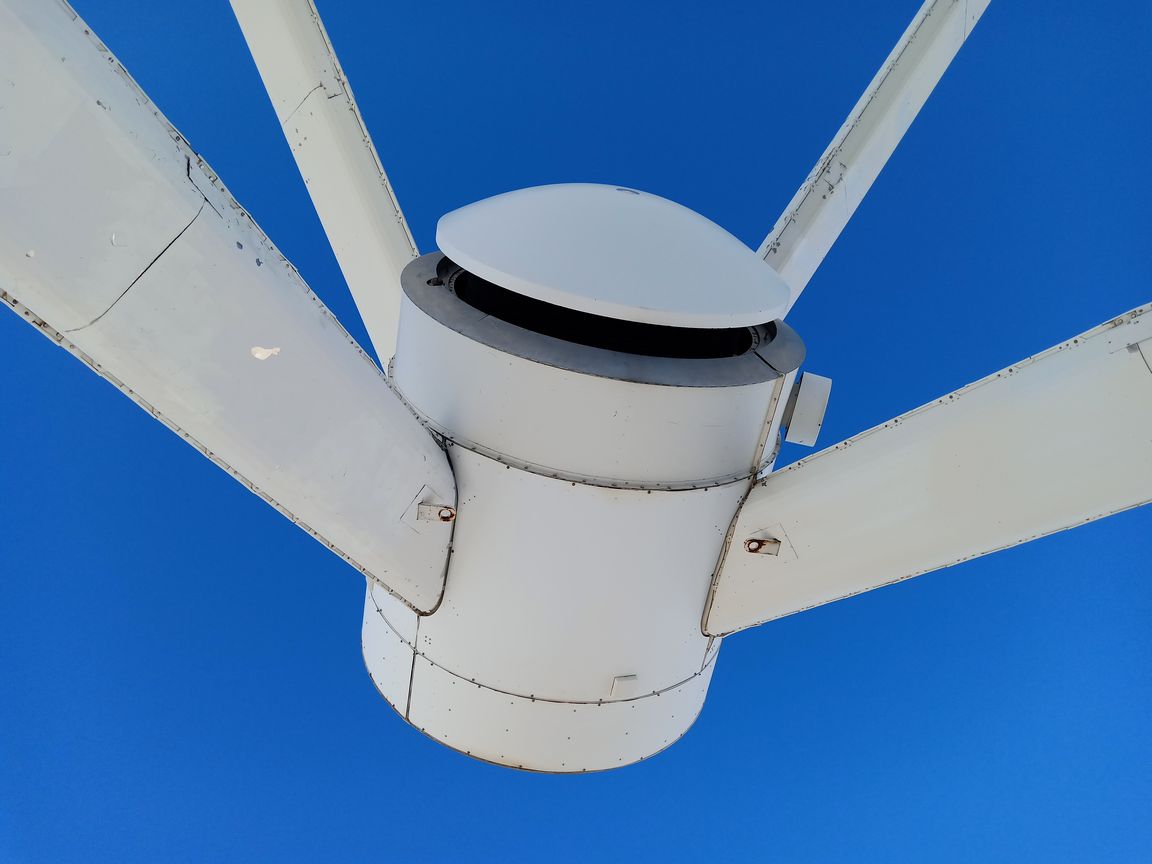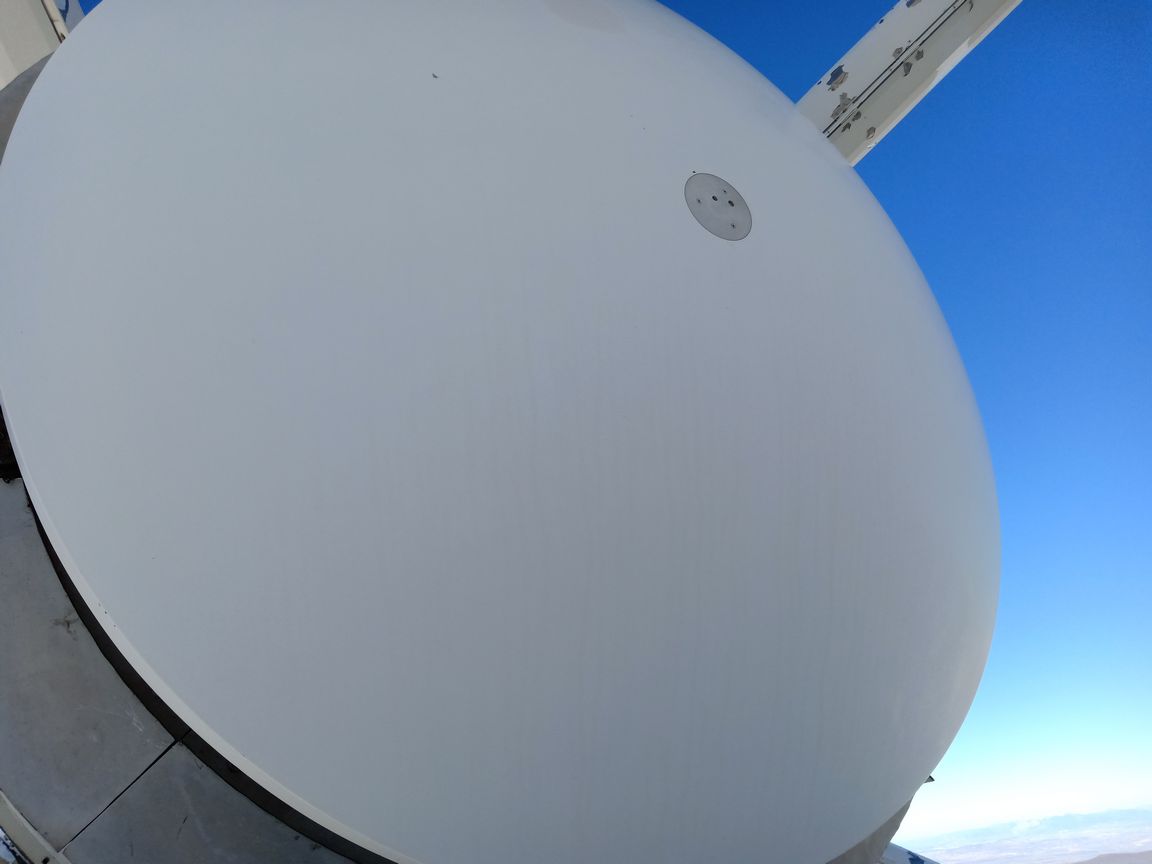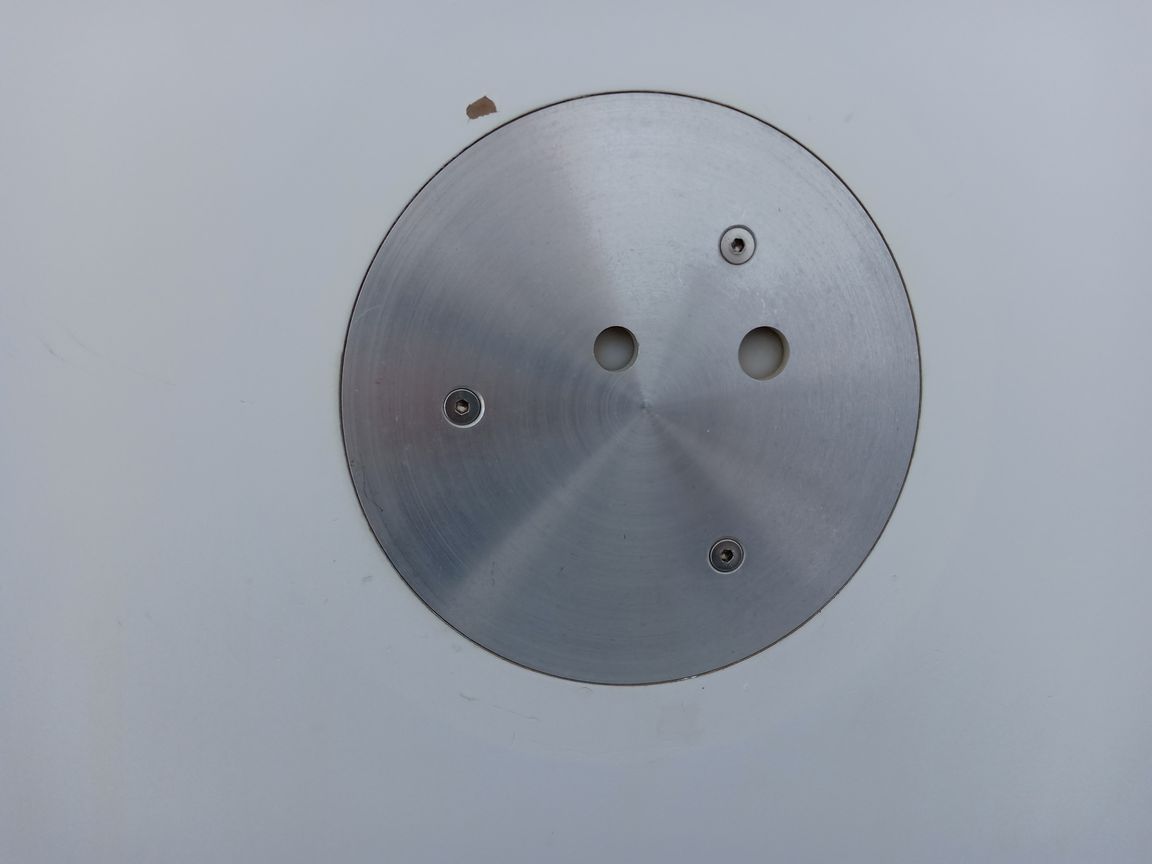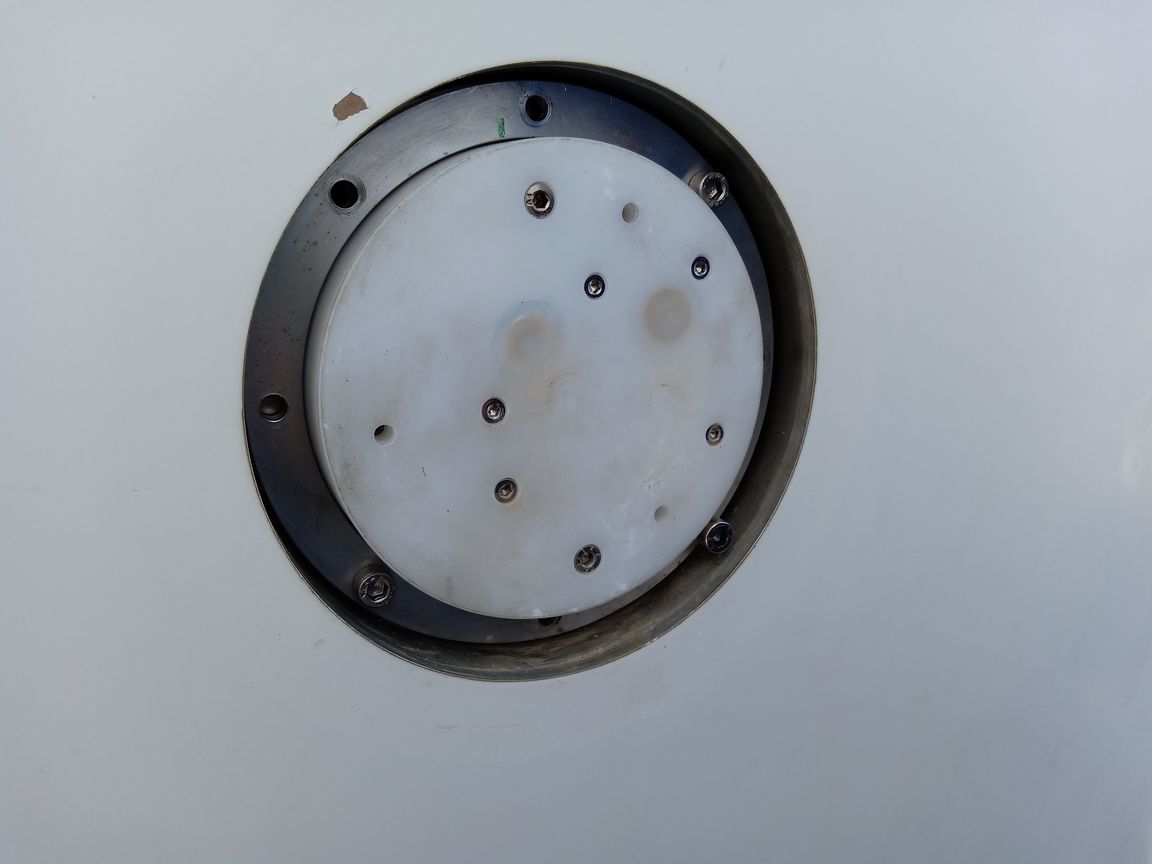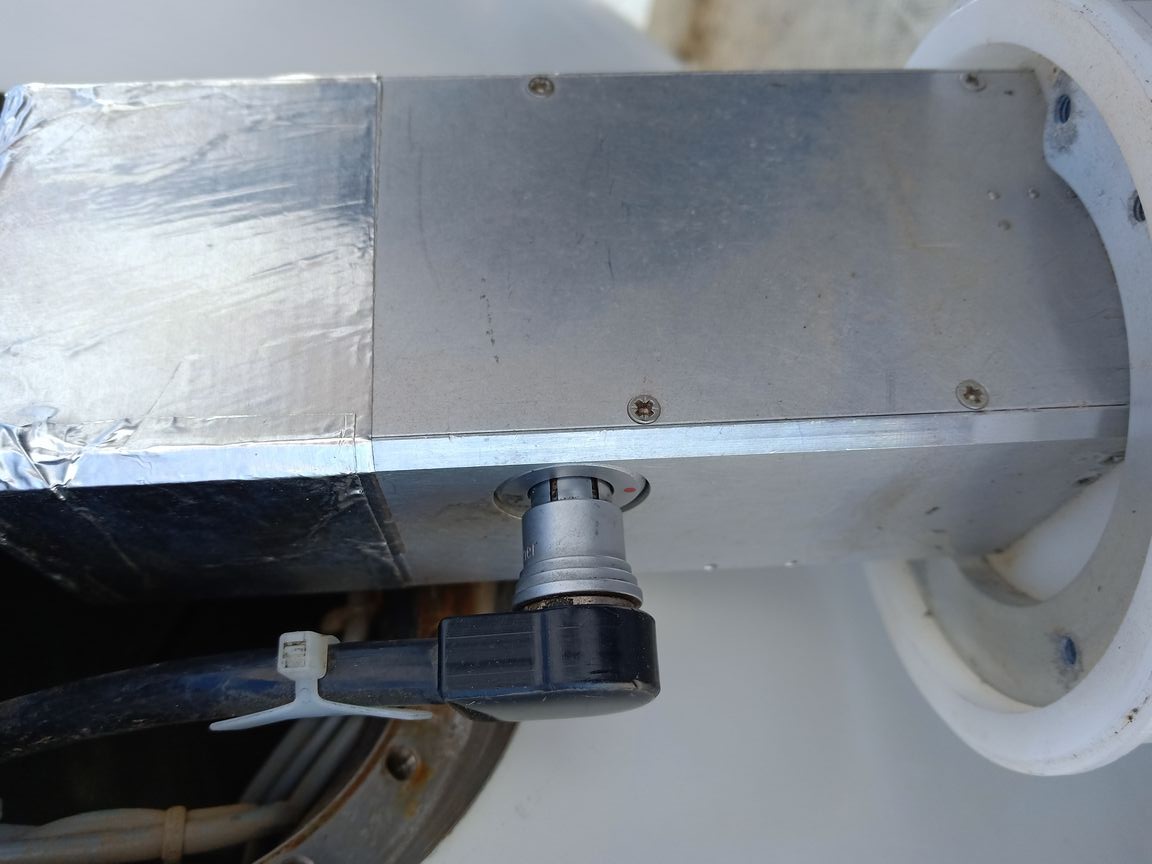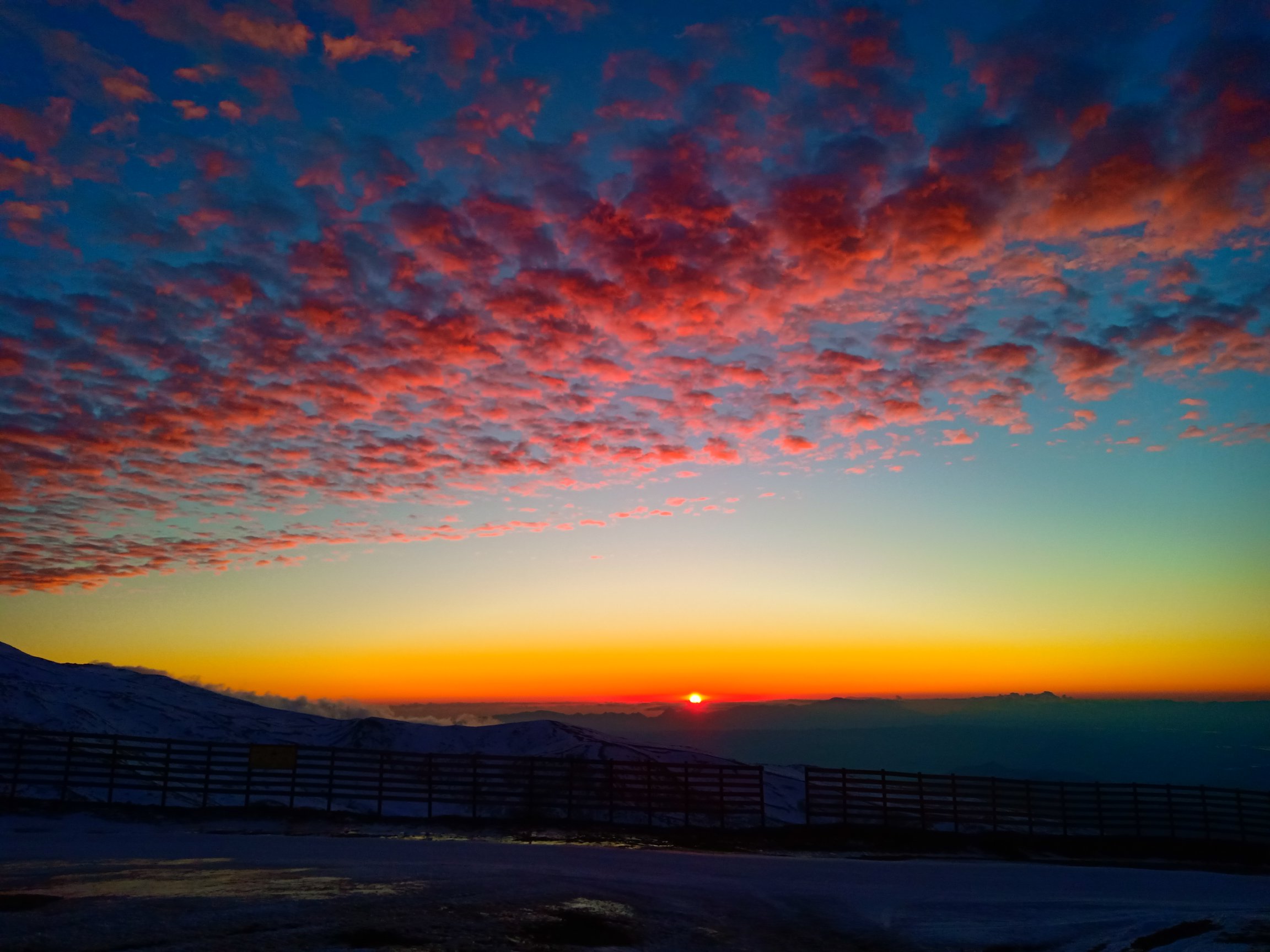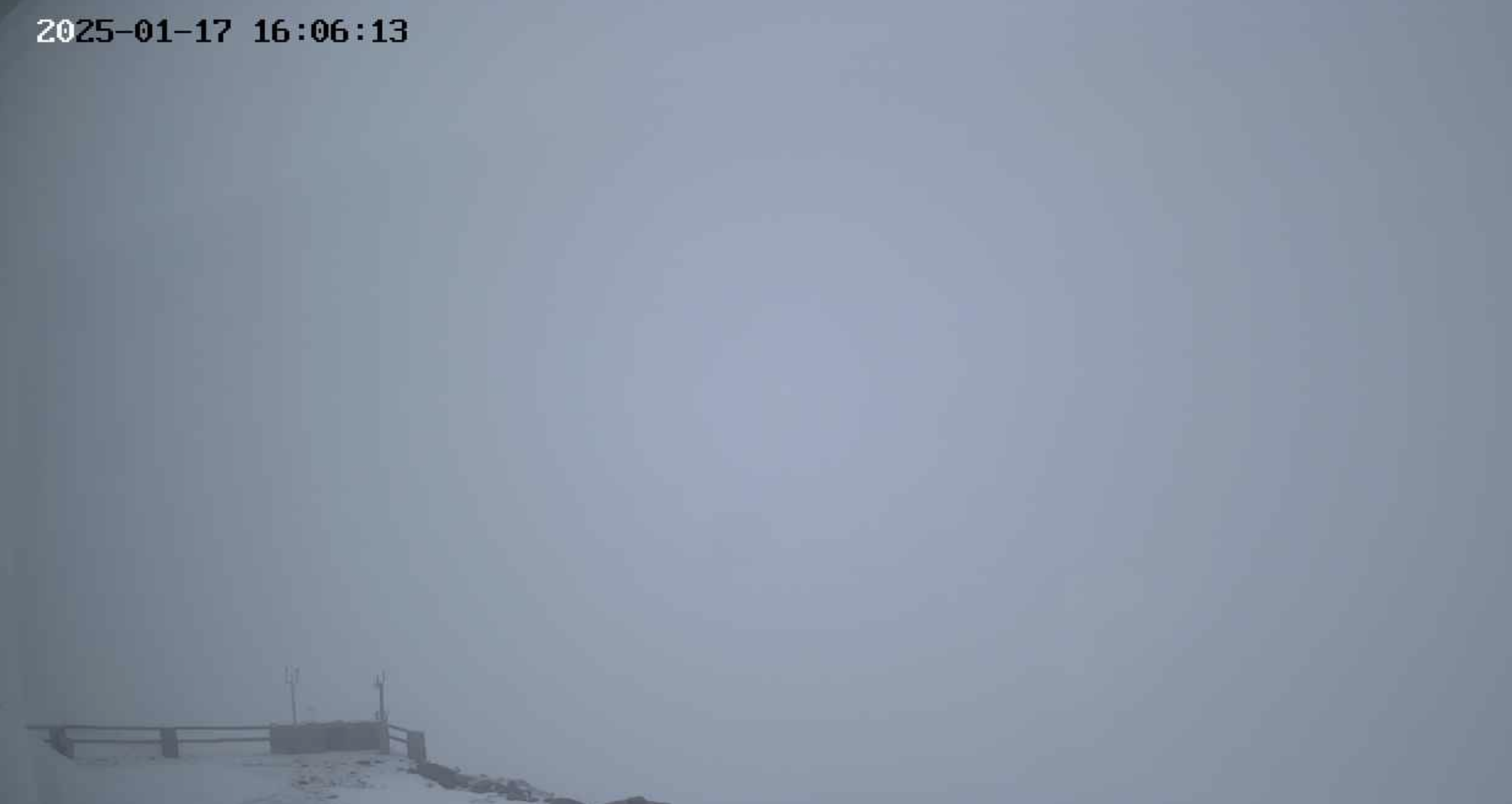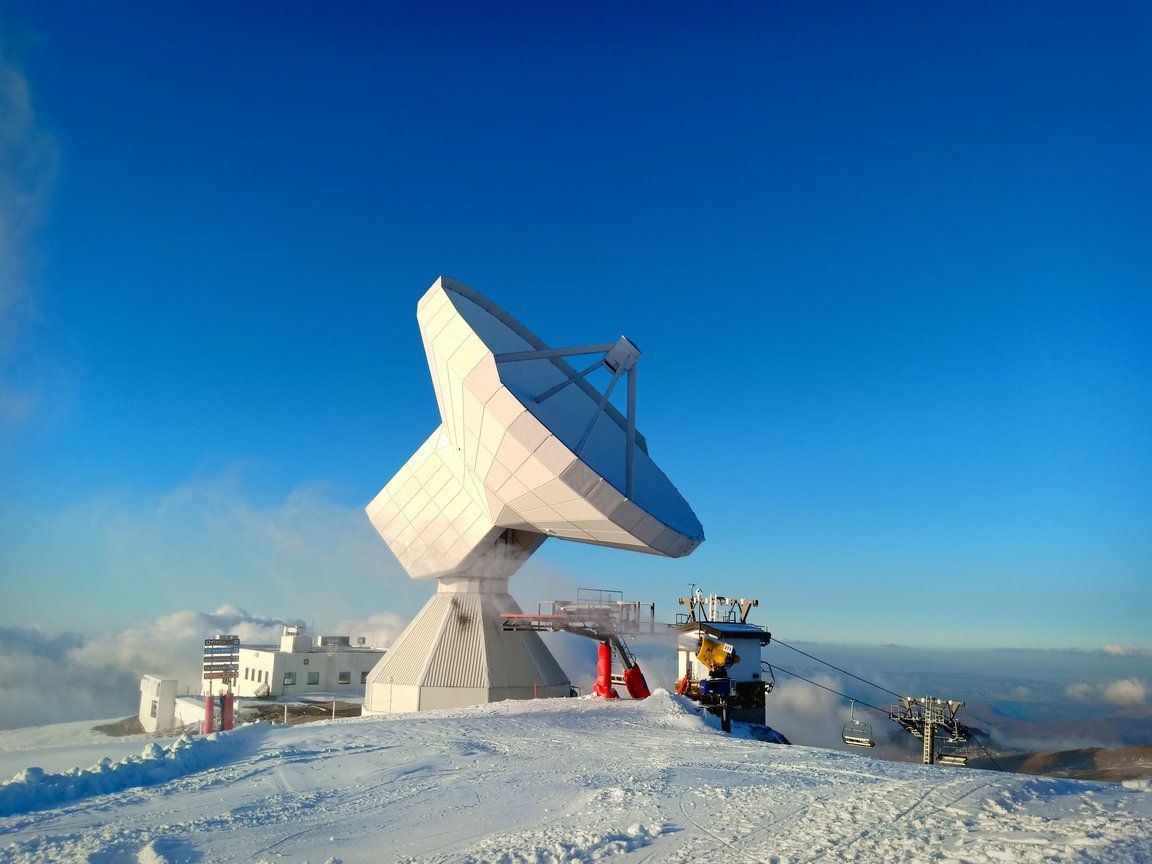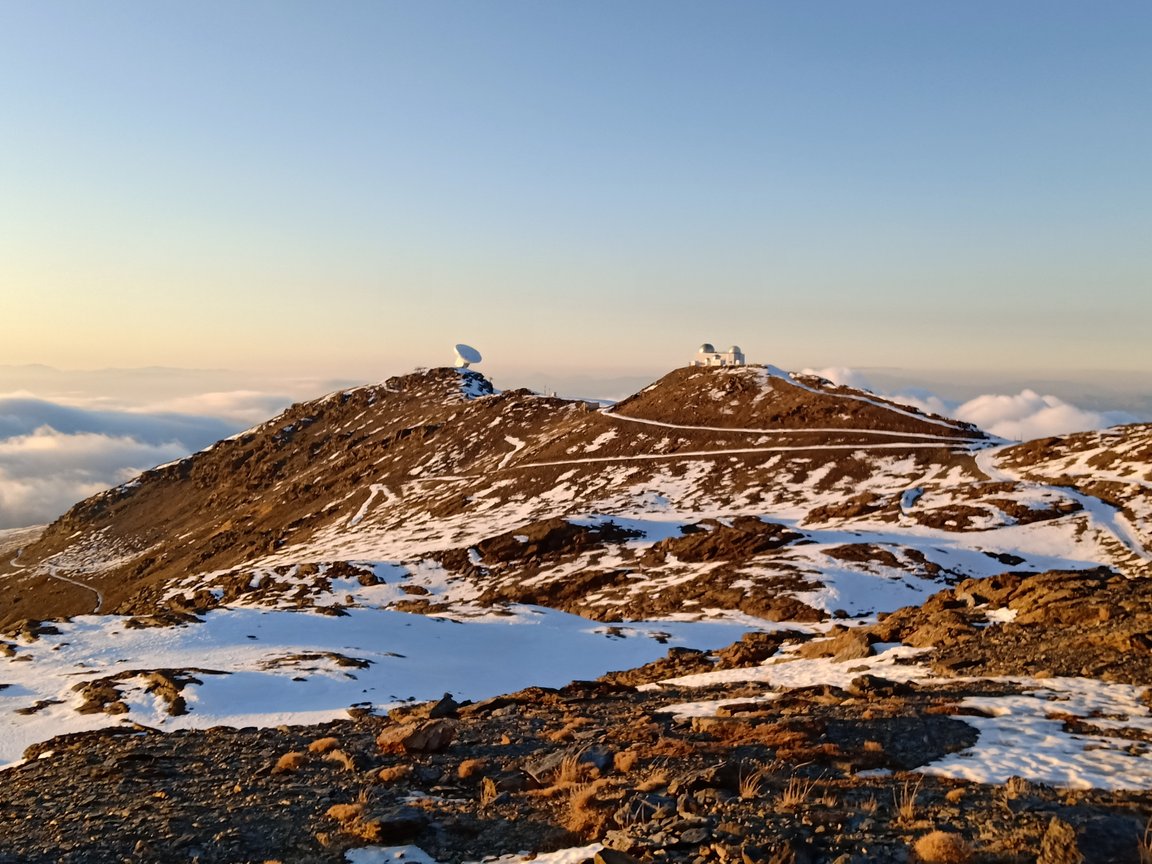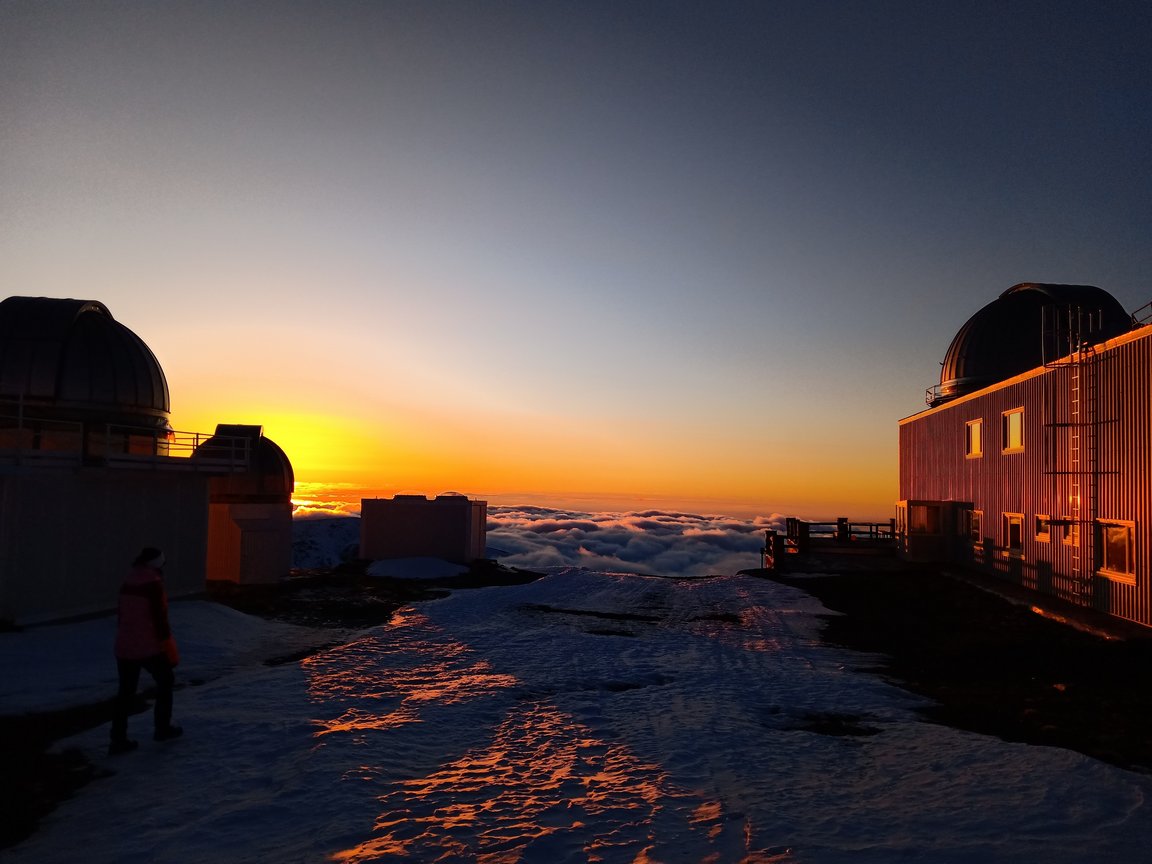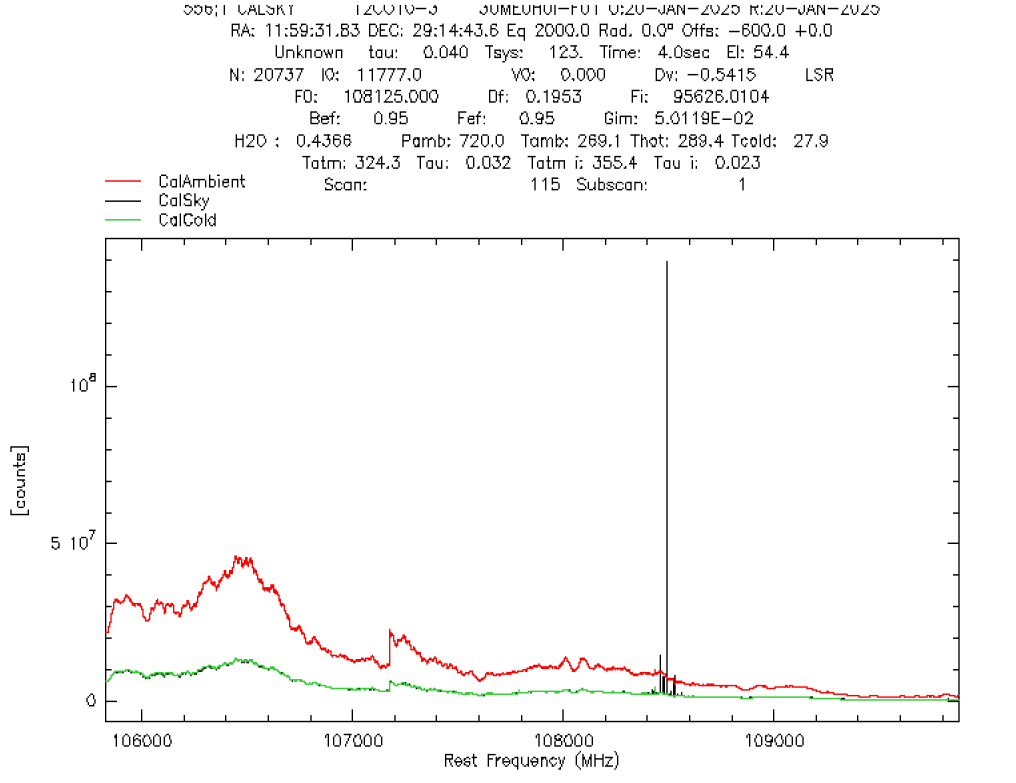Daily Reports
Observers on-site: Francisco Montenegro, Sofia Savorgnano, Sihan Jiao, Samuel Leclercq, Hamza Ajeddig, Stergios Amarantidis (AoD) and Angel Bongiovanni (stayed only Tuesday).
Operators: Juan Luis (day shift) and Gloria (night shift)
Jan 14th, Tuesday
14:00-16:00: During the maintenance Dave and Samuel used the platform to access the external calibrator in the secondary mirror (ExtCal in M2) to check its connector. It was not fully plugged in! See picture below. It was very difficult to plug it all the way through, we don't why there was so much resistance, but eventually after shuffling a bit the back ring it went through. Now we have again a response on the ExtCal GUI, for the first time since the COSMOCal test in October. The problem occurred probably during the Holography campaign in November. We leave the ExtCal ON, with SetHeaterPower at 100. So in principle the data files should have now the ExtCal signal in addition to the sky signal, both in separate tables, and ExtCal signal not affecting sky signal. To be checked and discuss at the NIKA2 meeting tomorrow.
16:00-22:00: Stergios: Starting with POL mode and DAQ at ~15:00 UTC with 11/5/40 bad pixels. Starting with pointing/focus on NGC7027 but the tracking command does not behave correctly (the telescope doesn't move on target's direction). Scans 92, 93 (pointing command) appear on tapas but there are no imbfits files generated apart from the antenna files. AS and the computer group were contacted. We have lost x hours due to this technical issue. Excellent weather conditions (tau~0.1 and wind speed at ~3m/s).
Many spindle errors, basically impossible to observe (see for example s97 or s102; check tapas for more details). One stacked scan (s108).
Continuing with the calib_1scan of NGC7027, MWC349 and CRL2688.
Around 16:00 UTC we stopped for 15min due to high wind (see tracking errors below).
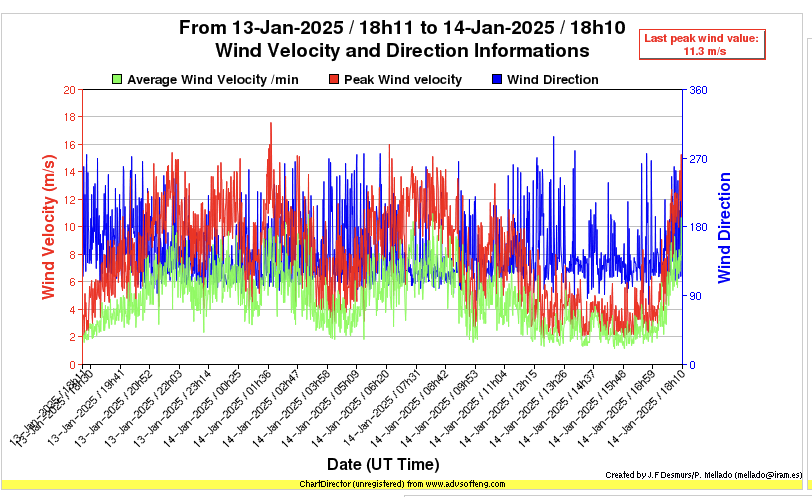
![]()
18:36 UTC: wind still high (gusts of ~10-12m/s), switching to Uranus and hopefully to the project 128-24. Uranus pointing and focus looks stable, wind decreasing so we move after calib1_scan to the project 128-24 at the source L1551-IRS5 around 19:20 UTC. After scan 134 there was a spindle error without the telescope observing anything. So far all spindle errors happened with relatively high wind and elevation above 50 deg. One repetition on this source (~1h) with one spindle error interfering with one of the maps. Spindle errors (scans 140, 145) and stacked scan (s141).
21:30-04:00: Samuel+Hamza:
- wind still a bit high (gusts of ~10-12m/s), but PIIC doesn't complain on tracking errors, tau225 ~ 0.1. Continue with project 128-24, source L1551-IRS5. Things went smoothly from s137 to s148, a spindle error during s149. Bellow a screenshot from IDL to see quick look polar of s137:
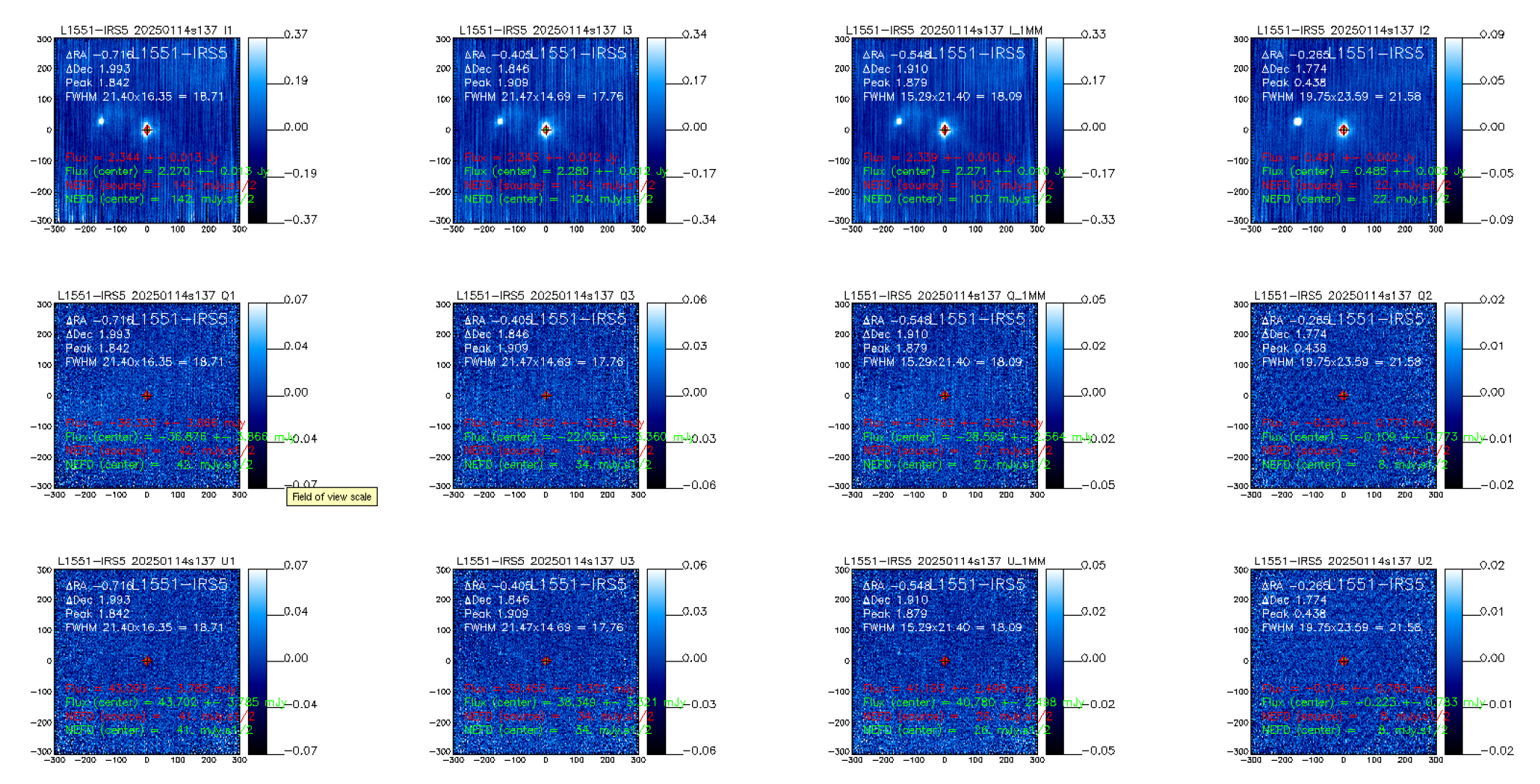
- 22:00 UTC restart acquisition because after the spindle error of scan 149, the IMBFITs were not created anymore, hopefully we can recreate from row data s150-154. s155 = 1st one after acquisition restart. s164 = redo s149.
- 22:48 UTC change project: calib in nikaw-24 on Uranus before going to project 015-17... but stop before observing it at 23:29 UTC because of too high wind.
- 01:50 UTC: Restarting observation by doing pointing and focus after the break. We repeated the track and focus because the track was not good and Uranus was at low elevation and one spindle as well.

- We used the 0529+075 for pointing and focus because it is close to B-FUN source and Uranus is at low elevation. With a stable focus and good opacity, we run first round of NGC2024S at low elevation ! After NGC2020S is very low in elevation, we switched to GGC2264 after doing the pointing (did not repeat the focus as it was very stable all the night). We observed GGC2264, but we could not finish the round as the source is going below 30 deg.
Jan 15th, Wednesday
04:00-10:00: Francisco:
Small overlap with Hamza. Finishing up the B-FUN project with a skydip after the last science map.
- 03:15 UTC : skydip at the azimuth of the last scan. No automatic reduction showing up in PIIC. Wind going down a bit. A few gusts around 12 m/s.
- 03:34 - 04:10 UTC : At 03:35 we got a spindle error but the scan was finished. Doing some calibration measurements on weakly polarized quasars as instructed by Stergios. Doing first 3C273 and then 3C386. Focusing before the first calib scan.
- 04:10 UTC: End of polarisation observations. Switching to total-power. Gloria goes to the telescope while it is slewing the full azimuth range. She sees that the polarizer is spinning. We cancel the tracking and she follows the procedure to stop the spinning grid and stops the NIKA software. Then she goes back to the telescope and removes the grid. Finally she restarts the NIKA software again.
- 04:50 UTC: Starting observations in total power. A pointing scan shows everything fine after the removal of the grid and the restart of the NIKA software. Afterwards, focusing becomes very difficult because of the higher winds resulting in relatively large tracking errors. We also got a spindler error that cancels one of the focus scans. After 1h or so, I manage to get a full focus scan and apply the correction. Then I switch to the science project.
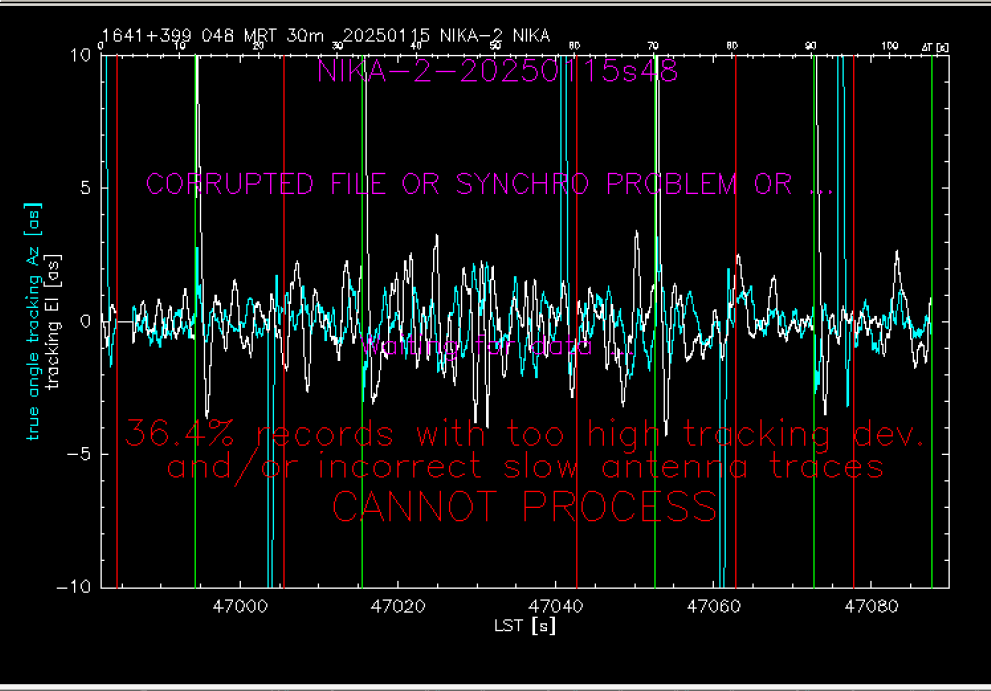
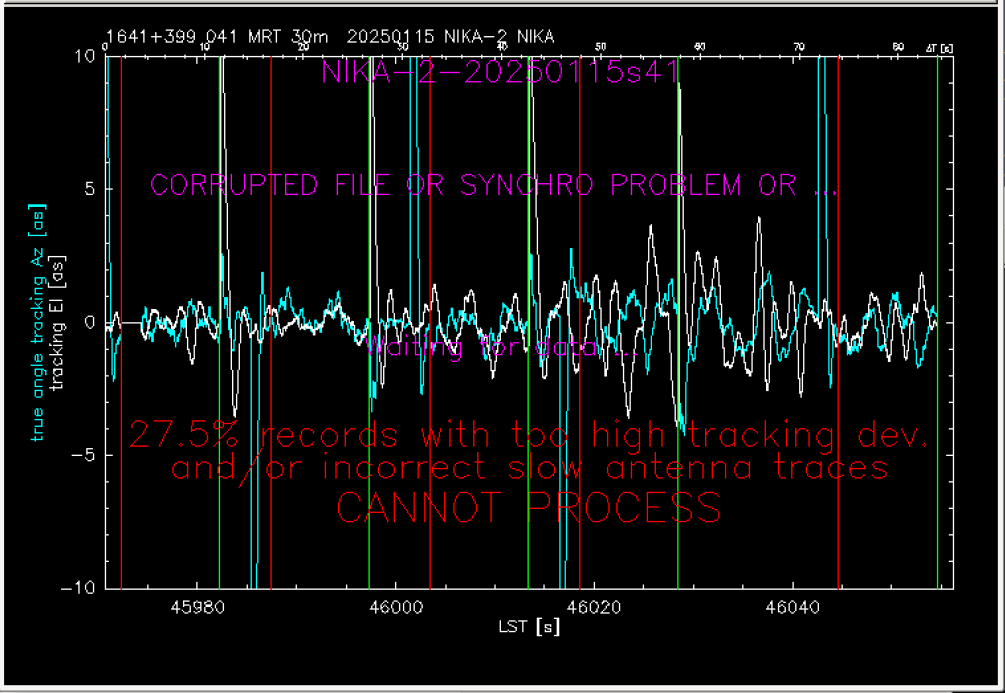

- 05:58 UTC: Pointing scan on a closeby source to the target. Then repeating one of the scans with tracking errors from last night (4/4). After that, a full loop is executed with all 4 angles. At 07:37 UTC we did a repetition of map 3/4 as it showed some tracking errors yesterday.
We focused on NGC7027 and did a calibration scan before and after the focus, to see any difference. Later I did a calibration in CLR2688 and a skydip.
10:00-16:00: Sofia:
- Switching to polarization mode, lost KIDs: 29/3/35; starting on 3C286 for calibration and testing pointing; pointing and focus is fine; tracking on 1741-038; pointing fine; launched set of 6 observing scans of W43 (project 132-24), changing in the observe_w43.pako script the number of repetition from 1 to 6; spindel error when scan 95 was running.
- 11:31 UTC: switching to project 145-24, using 3C454 as a calibrator; focus is a bit tricky, maybe due to the sun exposure, so taking some time to optimize focus and pointing; after scan 122 we have many homology and spindle errors; focus more stable now after a calib1_scan we moved to a pointing source close to the science target G23 of 145-24 and then to the G23.
- 13:48 UTC: switching to project 128-24; running one round of all 3 scripts @nkotf on B335.
16:00-22:00: Sihan:
- keep the same project 128-24 for the second round of all 3 scripts @nkotf on B335. Doing pointing and focus with Uranus.
- 16:40 UTC we are still trying to get good pointing and foucs. We met high tracking problem when doing focus because of the wind.
- 16:58 UTC we stop due to the high winds.
- 17:35 UTC we had a try but still meet high winds. - 18:35 UTC had another try.
- 18:50 UTC the weather is good to do observation now. Switching to project 128-24
- 20:10 UTC observing L1551-5 for the second time.
22:00-04:00: Samuel+Hamza:
- Stable conditions form 22:15, windy but observations are possible. Pointing and focus was done with Uranus and another pointing near to the source.
- 21:43 UTC We started observing BFUN NGC2024S, but at 21:58 UTC we started to have a series of many errors : spindle, stack scans, homology... After several tries to redo scans we ended up doing skydip at 22:22 UTC and the series of errors stopped (could there be a link with possible encoder errors, fixed by the big change of elevation from the skydip?). While trying to debug this series of errors we went back and forth between projects (nikaw-24 <-> 015-17) and sources, when we finally wanted to resume maps on NGC2024s we forgot to change the source name and lost 30 min on a quasar. Back to NGC2024S one good scan and then again a series of spindle and homology errors. Lot of time lost tonight because of these errors.
- 23:51 UTC calib 1 scan on Uranus, and focus at 00:00 UTC... but problem processing it. Had to restart PIIC and redo focus. Even though it's 3.5 h later and Uranus is now pretty low (25 deg el), only 0.16 mm of M2 Z focus difference with respect to begin of shift (confirms what we were seeing on FWHM from the pointing scans taken in between). Conditions are very stable (p2p ~ +-1 Jy/beam). No spindle error or other during all the time on Uranus. 1:00 UTC Back again to NGC2024S. At last a series of scans without spindle error.
- 1:48 UTC Change source, point and calib 1 scan on Mars, then go to NGC2264 at 2:07 UTC... And the spindle errors are back again GRRR. Only 2 good scans on NGC2264. We switch to Total Power and give the hand to Francesco at 3:00 UTC (4:00 Local).
Jan 16th, Thursday
04:00-10:00: Francisco:
Small overlap with the previous shift. They are done with the polarisation project. tau_250 is about 0.23.
- 03:30 UTC: We switch to total-power mode. Ceph sources in project 114 are at 25 deg elevation and because they are circumpolar they will need about 4h to get to 30 deg elevation.
- 03:45 UTC : Focusing on 1803+084, small correction. Taking a reference calibration scan. Then starting project 189_24 with pointing on 1641+399. This is everyday the pointing source and it is very bright. I take a calib_1scan for reference. Then start a loop with 4 OTFs. Very stable tau around 0.25 all over the loop.
- 05:30 UTC : Checking again pointing on 1641+399. Applied correction and started a second loop. One of the maps looks noisy so I repeated it. Average tau remained around 0.25, but the monitor shows a big jump.
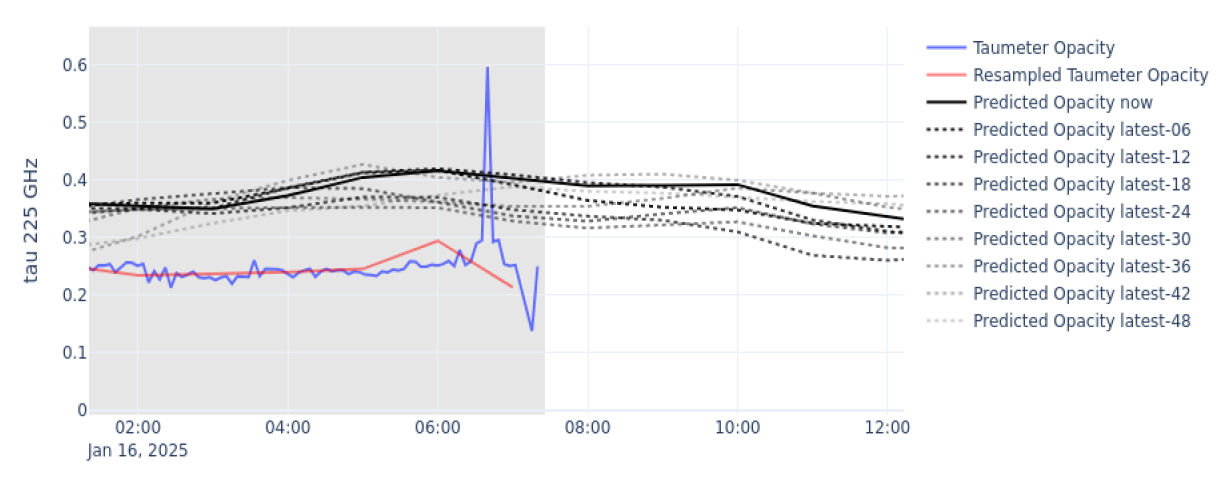
- 07:10 UTC : At the end, I take a calib_1scan on the pointing source to have another reference at high elevation. Focus looks ok so no need to refocus. Switching to project 114-24. Pointing on nearby source and then starting observe_Ceph_3
- 07:24 UTC : Spindle error at subscan 20/31 of the first map. We let the map finish. During the second map we got a homology error so it was cancelled. I repeat the second map, which now ends ok, and decide to repeat also the first one, just in case.
10:00-16:00: Sofia:
- Starting a calibration session on flux calibrators NGC7027, MW349, CRL2688, doing pointing, focus and calib_1scan. Tau is 0.21 at the moment, very stable conditions.
- 10:00 UTC started observing project 114 and source Ceph_3 in particular. Run one round of both maps.
- 11:00 UTC switching to polarimetry mode and targeting project 145, using 3C454 as a calibrator; bad KIDs: 26/3/40; after scan 111 finished, a spindle error appeared
- 13:29 UTC started observing project 128 on source B335; spike in tau at 14:20 UTC, reaching 0.5 then going back to 0.16. Spikes are appearing from time to time, probably due to interference or clouds
- 15:00 UTC completing the second repetition on B335 of project 128 before the end of the shift; very stable conditions, very low wind; no spindle error during this shift.
16:00-22:00: Sihan:
- 15:00 UTC started focus on 3C454. The clouds are round Uranus, do not get a good pointing.
- 16:00 UTC all the target sources are in the cloud.
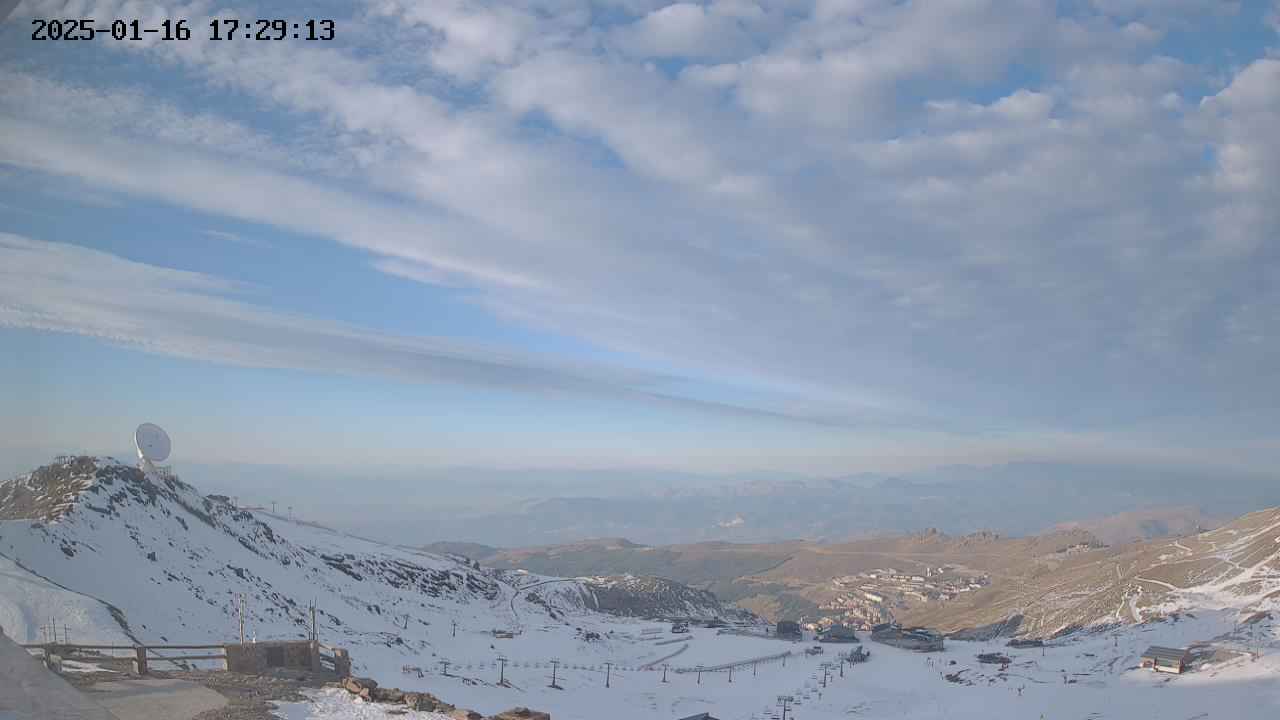
- we switched to EMIR. Still can not observe due to the bad weather and spindle errors.
- 20:20 UTC try focus with Mars. Everything looks ok, moving to 0458-020 for a pointing to a closer source but with no luck. We are trying another pointing SMA source from the sma_point.edb catalogue (see details on the .xephem directory).
22:00-04:00: Samuel+Hamza:
- 21:00 UTC impossible to do observations even with EMIR despite a relatively good opacity (tau_225 ~ 0.3), the sky is really too unstable, see for example how the beam is offset and turbulent on a relatively bright quasar taken just after a pointing and focus on Mars (at 3 mm / 100 GHz):


- 23:00 UTC. After several attempts with EMIR in test project over the last hours, we see little by little crappy pointings getting more and more confined to sources in the west part of the sky, where clouds stay thick, and nice pointing appearing for sources in the east part of the sky, were clouds disappear. Region out of clouds seem to have very good conditions, so we switch directly to NIKA2 Pol, we bet that by the time the system will be all set, the sky will be all cleared. After tones reloaded and tuning done: bad kids = 16/3/34.
- 23:25 UTC. Just arriving at Uranus, and spindle error followed by homology are back! A quick manual up and down in elevation by the operator seems to clear the homology problem like last night. On the 1st pointing tau~0.18 and p2p~1Jy/b, so sky conditions look good. Same problem as 2 days ago appears: the new imbfits making doesn't create the files of the focus sequence we ran after the pointing, the old imbfits making creates them. We restart the acquisition to see if it solves the problem while processing the data created with the old imbfits making. We don't know if there's a better solution, if someone knows one, it would be nice to write a little memo. Good pix = 25/3/36. Restarting acquisition didn't solved the problem. So we killed the new imbfits creation process and restarted it (instructions in the adequate readme file, looking at the commands history in the remote@mrt-dare1 screen).
- 0:17 UTC we finally have everything running well (telescope, acquisition, new make imbfits, and piic). tau~0.18, p2p ~ +-1.5 Jy/b. After good focus and pointing at last ready for the beam map... too late: by the time it will finish Uranus would be at 16 deg elevation... probably too low to be useful. Cancelled just after a few subscans. Damned!
- 0:50 UTC Project 128-24. Go to L1551-IRS5, only source of this project is still high enough, so we do the last iteration required by the PI to complete this source.
- 1:20 UTC Project 015-17. We observed NGC2264 at stable weather conditions, tau ~0.2, and stable focus.
- 3:05 UTC Beammap on 3C286.
Jan 17th, Friday
04:00-10:00: Francisco:
- 03:45 UTC : Checking pointing after beammap to see if there was any drift and confirm the FWHM. The pointing shows a small relative offset to the previous one (less than 1 arcsec in each axis). Beam shape is smaller than before, so maybe there was some issue with the previous pointing. Anyway, I repeat focus and the delta correction is also small (0.1 mm). So in the end I decide not to repeat the beammap on 3C286. Doing a skydip before finishing the project.
- 04:15 UTC : Gloria switching to total power. In parallel the antenna makes a full turn in azimuth (topo) to get to the next source.
- 04:27 UTC : Starting project 189-24. Pointing on 1641+399. Tau is around 0.18, very stable. No need to refocus as beam shape looks good. Launching a full set of OTF maps.
- 05:45 UTC : Checking pointing and finding only a small drift. Beam looks ok. Launching another set of OTF maps.
- 07:00 UTC : Rechecking pointing. Beam looks the same as before, no focus change. Starting two more individual maps as Ceph sources will get soon above 30 deg.
- 07:45 UTC : Switching to project 114-24. Pointing on 1928+738. Telescope still focused according to beam shape. Starting macro in Ceph_1 (not done yesterday). Elevation is 31 deg. Tau still around 0.15. At the end of the first map we got a spindle error but it seems to have finished correctly. After the error was fixed, I started the second map. By this time the sunlight starts hitting the antenna from the back. At the end there is time for a new pointing and 1 additional map. I selected the first map of Ceph_2. It was interrupted in subscan 55 because of the spindle error. Switching project.
10:00-16:00: Sofia:
- 09:12 UTC : starting flux calibrations on NGC7027, MWC349, CRL2688 as yesterday; spindle error at 09:20 UTC; skydip done at 09:50 UTC.
- 10:07 UTC : switching to polarimetry, bad KIDs: 24/4/37
- 10:51 UTC : started observing G23.01 of project 145; NOTE that snow is being sprayed right in front of the antenna, this could explain eventual weird features in the data
- 12:33 UTC : we stopped observations due to high instability (p2p ~ 10 mJy/beam), clouds covering the sky and snow still being sprayed
16:00-22:00: Sihan:
- Starting observations around 16:00 UTC (scan number 104 for the first pointing). Doing focus but the beam is toooo elogated with FWHM ~18*38
- 16:30 UTC we are in the clouds again and it is snowy.
- 19:10 UTC start again after the ice issue; tuning values: 24 3 36
- 20:00 UTC polarization beammap on Uranus
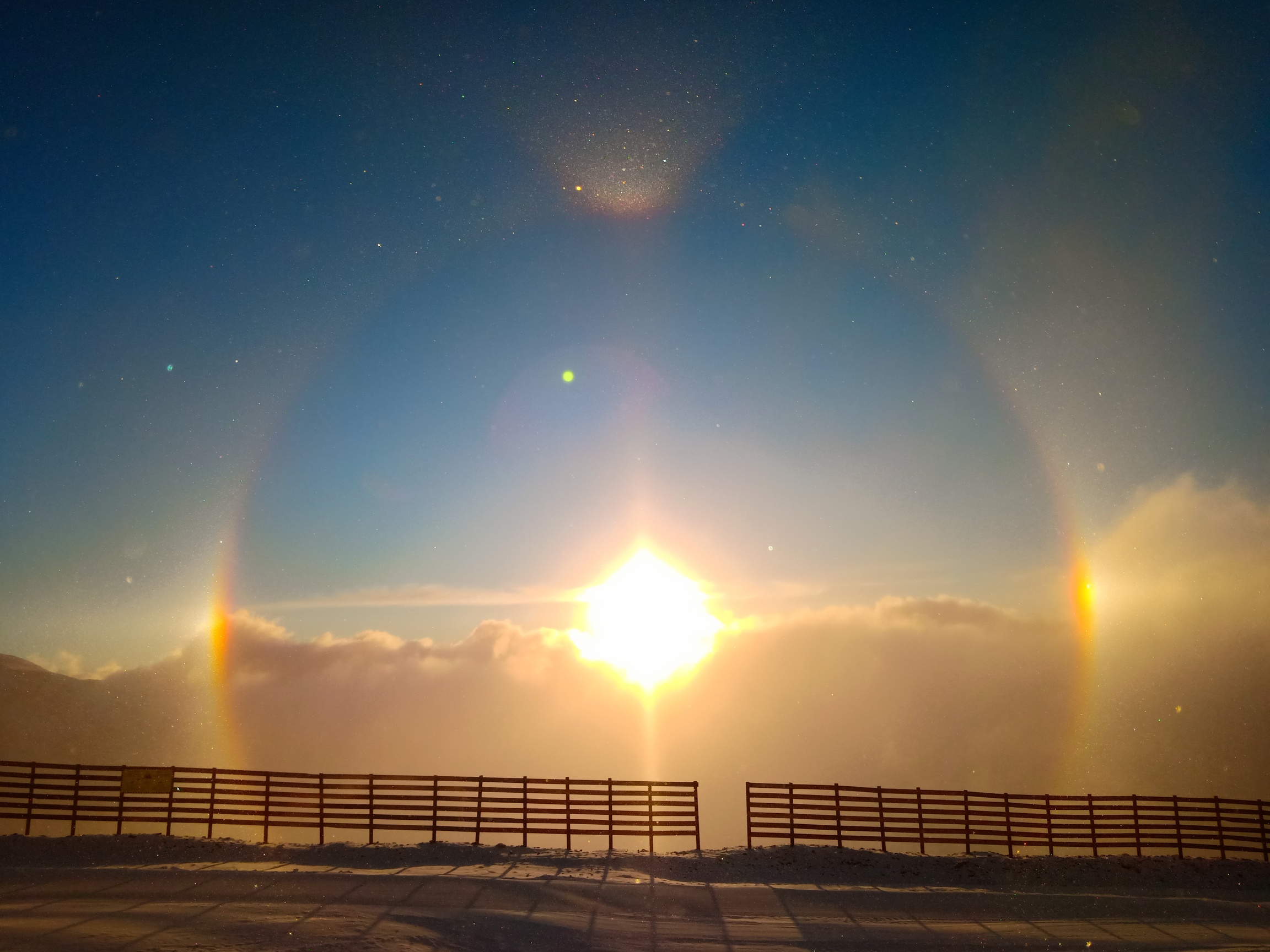 (the rainbow circle around the sun is not an effect of the camera optics but what we could see in reality with the naked eye!)
(the rainbow circle around the sun is not an effect of the camera optics but what we could see in reality with the naked eye!)
22:00-04:00: Samuel+Hamza:
- 21:00 UTC Switching to total power as tau is increasing pretty steeply from 0.15 to 0.23 in 1.5 h, and could continue like that up to 0.4 according to predictions. After re-tuning in TP, number of bad pix = 24/3/39.
- 21:10 UTC Project 188-24, source A0520.
- 22:35 UTC pointing, calib1scan, focus, calib1scan (check calib change after focus), test ellipticity evol with small defocus on pointing scans (not conclusive), total power beammap in not ideal conditions but not so bad (tau stable at ~ 0.22, stability p2p ~ +- 1 Jy/b, but FWHM ~ 17.3" x 19.0", and clouds starting to appear in sky), probably our last chance to get beam map this week according to weather predictions.
- 23:43 UTC Back to 188-24 / A0520 to finish the last iteration requested by the PI on this source. 00:40 UTC A0520 completed. Conditions much better than predictions, we switch to polarization.
- 01:05 UTC all set for polar mode, number of bad pix = 28/4/37. Unfortunately Uranus is too low, so go to Mars. On 1st pointing piic says file corrupted or synchro problem. Redo pointing and restart piic -> same. Elvin red on acqui, restart acqui -> OK that was the problem.
- 01:30 UTC Test focus on Mars, even if a bit too big (mars_beam ~ 21"@2mm, 16"@1mm) it should still work -> yes, required change wrt previous focus = 0.08 mm, consistent with expected amplitude. 01:45 set project 015-17.
- 01:45 Pointing on 0736+017 too see better sky fluctuation (Mars is too bright for that) and consistency of pointing wrt mars -> Huge fluctuations! p2p ~ 30 Jy/beam, <rms> ~ 120 mJy/b, and tau suddenly jumped from 0.26 to 0.40. All these indicators are way too big for polar mode (and even for total power). Clouds have arrived.
- 02:25 Pointing on 0736+017: p2p ~ 1 Jy/beam, <rms> ~ 76 mJy/b, and tau ~ 27, back to good condition, focus with monitor of p2p -> <2 Jy/b for all 5 scans, and focus values + beam FWHM consistent with good condition... but all Pol sources are now too low. Sigh! (frustrating). 3:00 UTC Switch to total power.
Jan 18th, Saturday
04:00-10:00: Francisco:
Samuel tuning the KIDs a couple of times to try to minimize the number of lost pixels. After the final re-tuning in TP, number of bad pix = 27/4/39.
NOTE: The snow spray behind the antenna (south) is being working all night as well as the snow grooming machine. May this affect the stability of the radiometer readouts?
- 03:30 UTC : Slewing the antenna to the other side, close to the target in project 189-24. Conditions are borderline (opacity is around 0.35-0.3, but seems to be dropping). After visiting various pointing sources in the area (at different elevations) one can see that stability is good (p2p within 1 Jy/b) and beam shape is stable. I repeat the focus scan on the strong qso close to CTRS27 and get only a small correction of 0.1mm compared to previous value.
- 04:10 UTC : Spindle error between scans, fortunately not affecting pointing. Taking a calibration scan on 1641+399, as requested in the instructions. Spindle error at the end of the scan, but it was ok. Around 04:30 UTC starting the map. Source is at 40 deg elevation and Tau_250GHz is fluctuating now around 0.28. First map is noisier than previous nights (59 mJy/b compared to ~45 mJy/b) but subsequent maps are getting lower noise (59, 55, 51, 53 mJy/beam). Although these differences may be due to different scanning angles with respect to elevation/airmass.
- 05:49 : Pointing check. Beam shape has not changed, similar conditions as before. Launching another observe script on CTRS27. Snow grooving machine not there anymore. Could this be related to the more stable tau readouts? Map rms are a bit smaller in this loop (for the same angles) so tau/stability has slightly improved. Spindle error in the 2nd map that needs to be repeated.
- 07:10 UTC : Another pointing check, very similar to before. And another map on CTRS27. Spindle error in the middle of the first map, that needs to be repeated.
- 07:40 UTC : Switching to project 114-24. Pointing on 1928+738. Beam shape looks still decent, I will finish the 2nd map in Ceph_2 that could not be done yesterday. Source elevation is 33 deg.
- 08:10 UTC : Pointing and then running macro on Ceph_1
10:00-16:00: Sofia:
- 09:09 UTC : starting the shift with usual flux calibrators NGC7027, MWC349 and CRL2688, doing pointing, focus, calib_1scan and then skydip
- 09:59 UTC : switching to polarimetry mode and moving to 3C286; bad KIDs 25/4/41; 2 spindle errors and 1 homology error while taking @calib_1scan on 3C286
- 10:40 UTC : started observing W43 for project 132; running one repetition that lasts ~1h; 1 spindle error at 11h46 UTC; also note that snow is again being sprayed in the antenna direction;
- 11:45 UTC : moving to 3C454 for pointing and calib_1scan, changing topology; we are having many spindle errors, probably happening as a consequence of large movements in Az, then clustering for 3/4 times;
- 13:17 UTC : spindle and homology errors in a row...
- 13:45 UTC : testing for spindle errors, moving in Az only to check if it triggers the alarm
- 14:00 UTC : clouds are covering most of the sky, tau up to 0.35, stability ~ 20 Jy/beam; in the meantime, we perform other tests to tackle down the spindle and homology errors --> moving in Az only; from 145deg to 270deg in Az; no errors coming up during these tests, the sky is clearing out, so testing stability
- 14:47 UTC : testing stability on 3C454, p2p ~ 5 Jy/beam, trying a focus but stability is still too slow... have to wait
16:00-22:00: Sihan:
- at the beginning of the shift the weather improved thus we moved to Uranus and project 128-24. Spindle and homology errors (see scans 142 and 143), the operator moves the antenna by 20-30 degrees in elevation to possibly fix the issue. Trying again...
- 16:20 UTC try to do focus on Uranus and got stable values.
- 16:30 UTC calibration scans and plan to observe project 128-24 then.
- 16:40 UTC start observe Per-emb-25 in project 128-24.
- 19:15 UTC do pointing, focus, and calib_lscan on Uranus and then switch to project 135-24.
22:00-04:00: Samuel+Hamza:
- 21:30 UTC We switched to BFUN project (015-17), start pointing, focus, calib1scan on Uranus, then direction NGC2024S [try to catch it before and after culmination (meridian transit) to have data for a possible test of the transit (CLUD) method in addition to Uranus reference, but the 1st scan starts exactly at transit... besides the distance to north pole is quite high to the object doesn't change much orientation during its travel through sky, the transit method would be more efficient with source much closer to north pole... so the transit idea was not so great for that one, but anyway it's good to go there to carry on the iterations requested for the project]. Pointing & Calin1scan on Uranus after the series of maps.
- 23:10 UTC project nikaw-24, focus & beammap on Uranus. Quite good sky conditions tau225 ~ 0.2 (good, not excellent) but p2p < 1 Jy/b (excellent)!
- 00:10 UTC project 015-17, back to source NGC2024S (original plan was NGC1333 but too low now). calib1scan on Mars, focus, calib1scan.
- 01:35 UTC source NGC2264. calib1scan on Mars. sky condition still good and stable, tau225 ~ 0.16, p2p ~ 0.5 Jy/b ! <rms> = 63 mJy/beam.
- 02:50 UTC project nikaw-24, focus & beammap on 3C286.
Jan 19th, Sunday
04:00-10:00: Francisco:
- 03:43 UTC : Beammap finished. Doing a final pointing on 3C286 to check if there was any drift during the beammap. Datafile is big, so while it shows up I move the antenna away from the azimuth limit and Gloria is switching to total power.
- 03:55 UTC : Starting project 189-24. Checking pointing source and taking a calibration scan before starting. Starting loop from map#2 to continue from yesterday.
- 04:57 UTC : Checking pointing and then repeating the loop. Same thing again at 06:10 UTC.
- 07:15 UTC : First spindle error of the shift... map interrupted in the middle. Repeating 4/4. After this is finished, a final pointing and moving to 114-24.
- 07:40 UTC : Switching to 114-24. Pointing on 1938+738. Beam looks still very sharp (FWHM 17.2 x 18.6 arcsec) so no need to refocus yet. Applying pointing correction and starting macro on Ceph_3.
- 08:15 UTC : Going directly to Ceph_2, I don't think there is need to point before, as sources are moving very slowly on the sky (circumpolar).
10:00-16:00: Sofia:
- 09h12 UTC : starting the shift with usual flux calibrators doing pointing, focus, calib_1scan and skydip;
- 10h02 UTC : switching to polarimetry mode; bad KIDs 17/3/39; calibration on 3C286, no need to re-focus;
- 10h11 UTC : observing G23.01 for project 145, finishing 3/4 and 4/4 maps, unfinished yesterday;
- 12h30 UTC : observing W43 for project 132 for ~30 mins (2 rounds);
- 13h45 UTC : calibrating on 3C45, then moving to project 128; one full repetition on this source;
- 14h50 UTC : moving to project 166 and source CasA; starting preliminary calibrations on 3C454;
In the afternoon, Samuel checked elements for the March NIKA2 upgrade that are already there: lenses and Pet(it) Interferometer Martin-Puplett. The pictures below show the 2 AR surfaced lenses to be put in front of Arrays 1 & 3, the PIMP frame, the PIMP itself, the PIMP opened showing motorized K mirror and black bodies, the Raspberry control unit on top of the grey box electronics, the grey box back mostly plugged, the main screen of the PIMP control software, and the PIMP output with the 2 lenses that can be mounted on it.
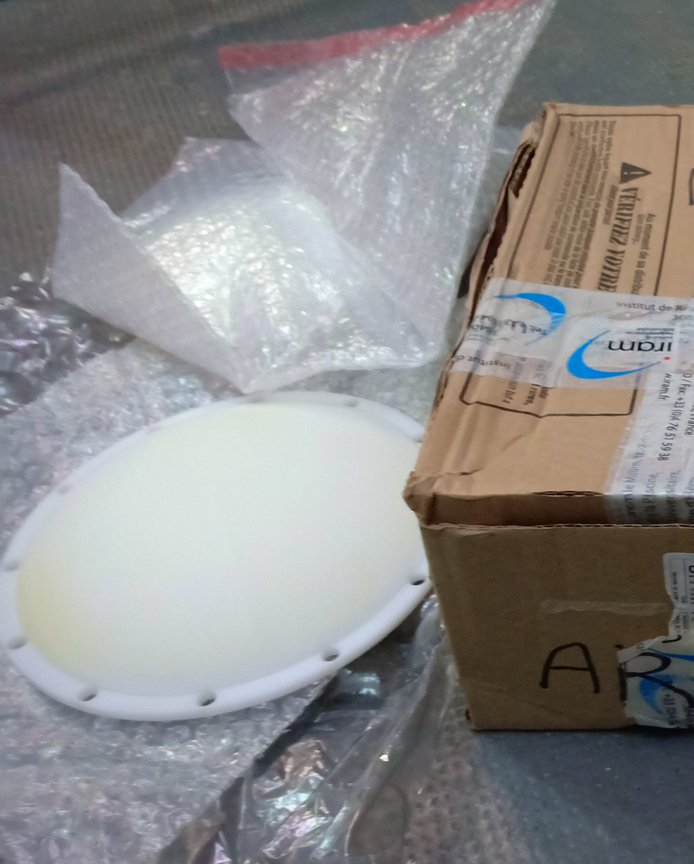
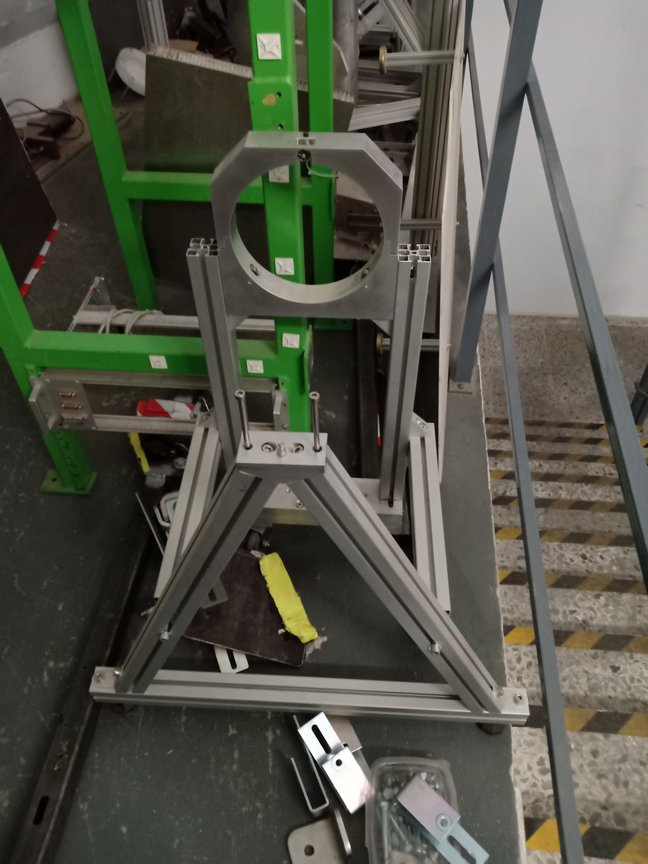
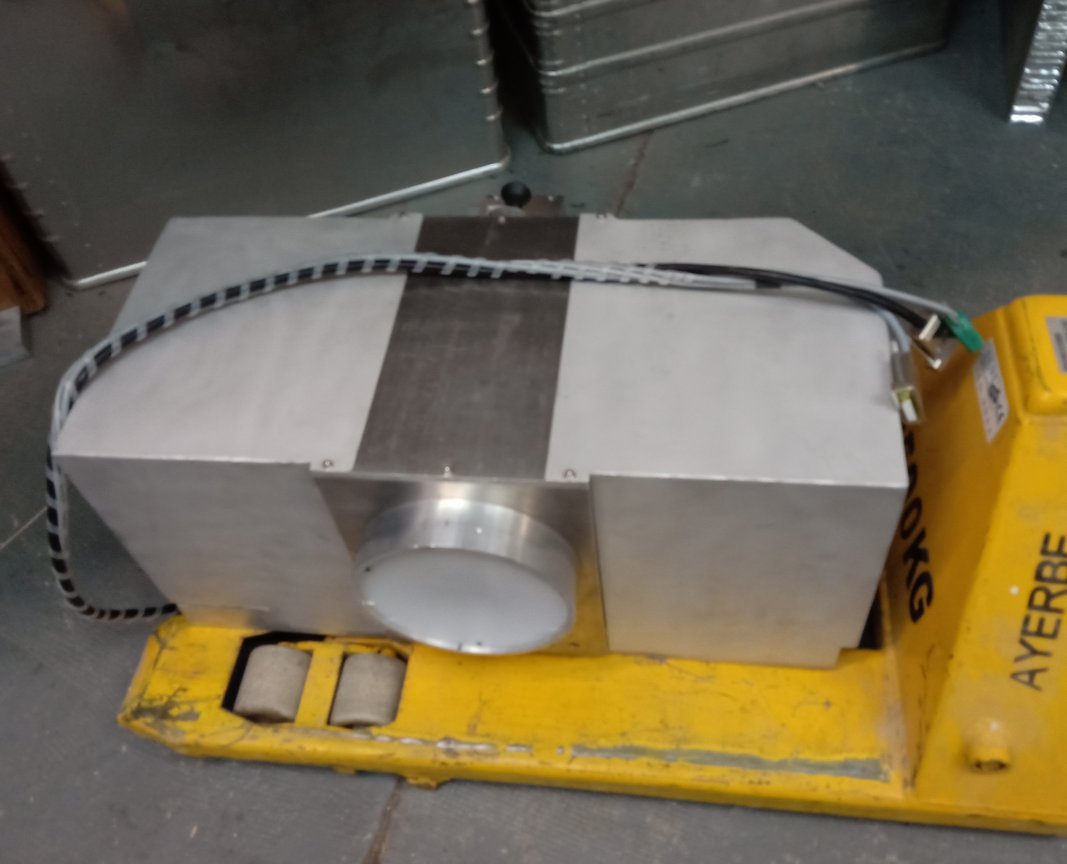
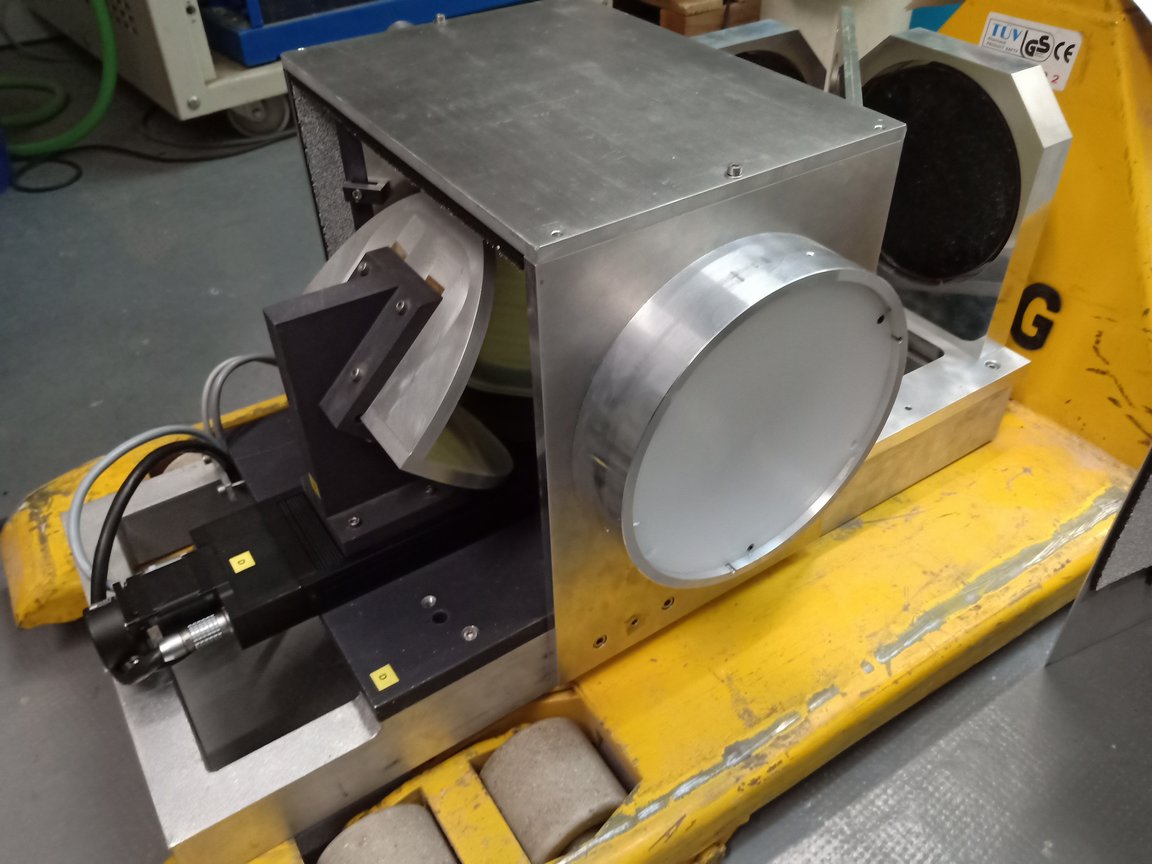

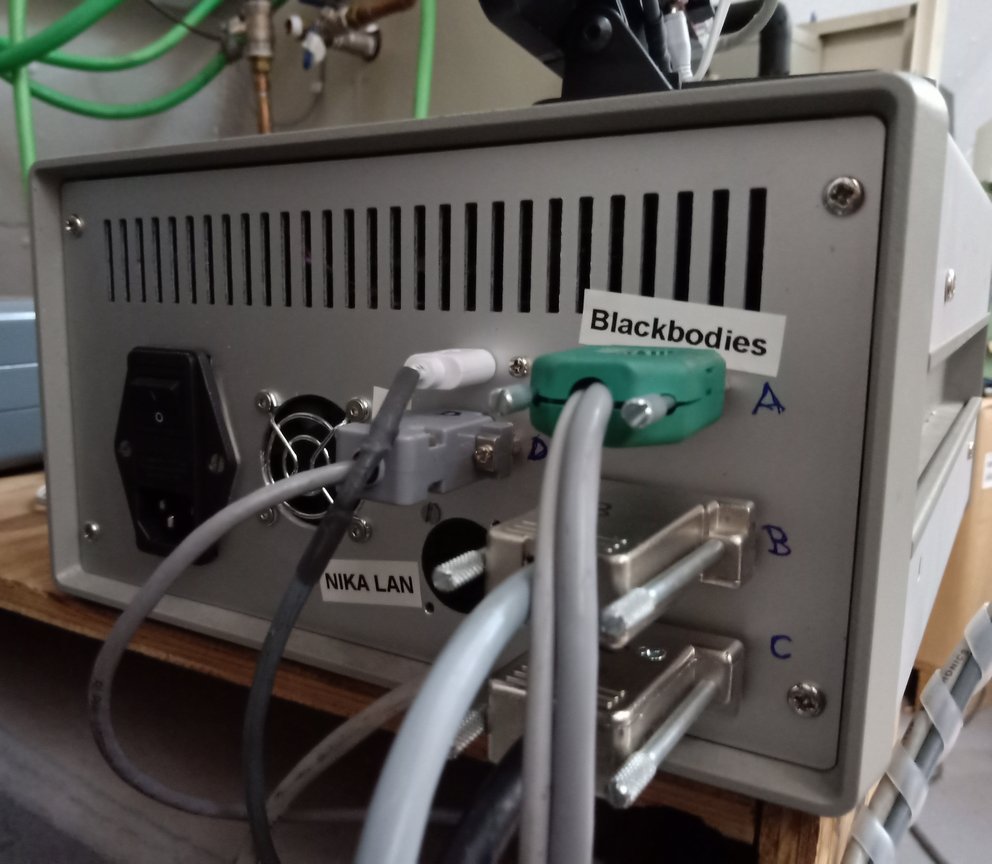
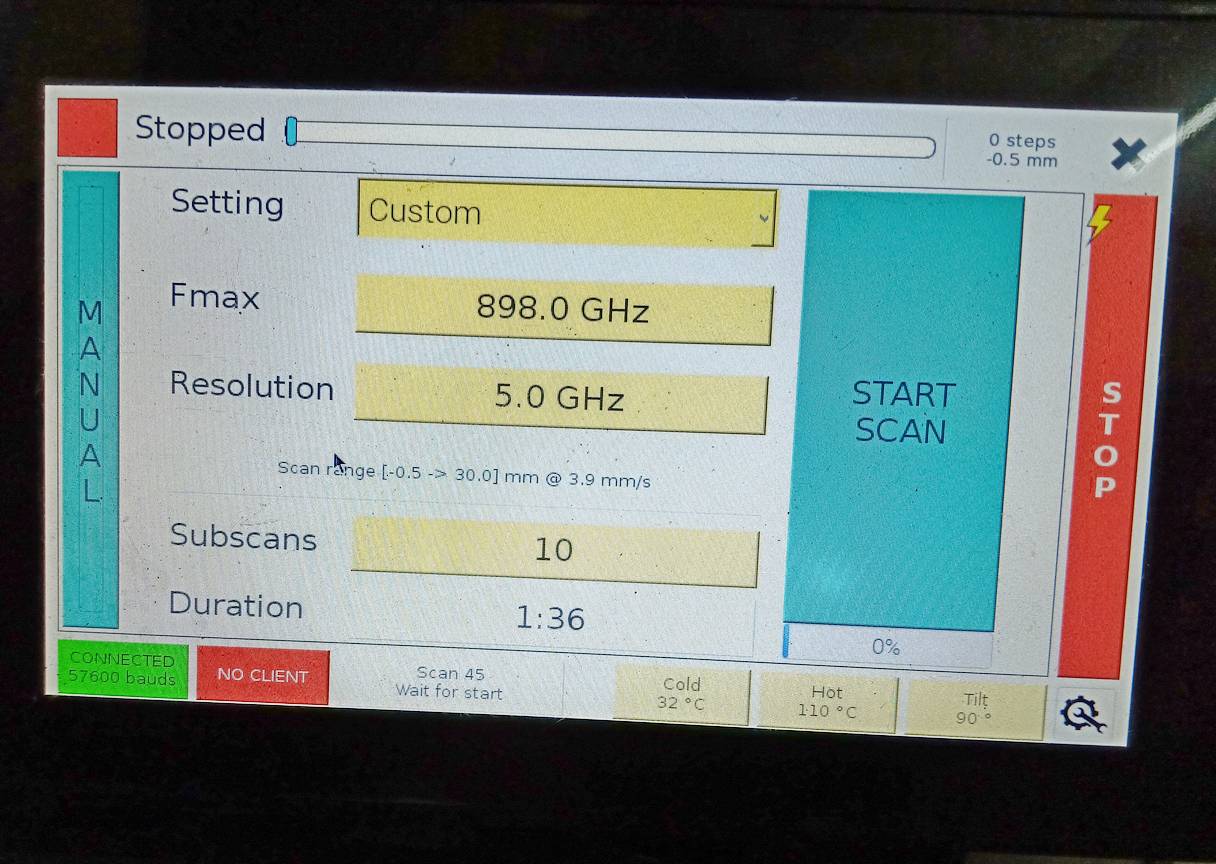
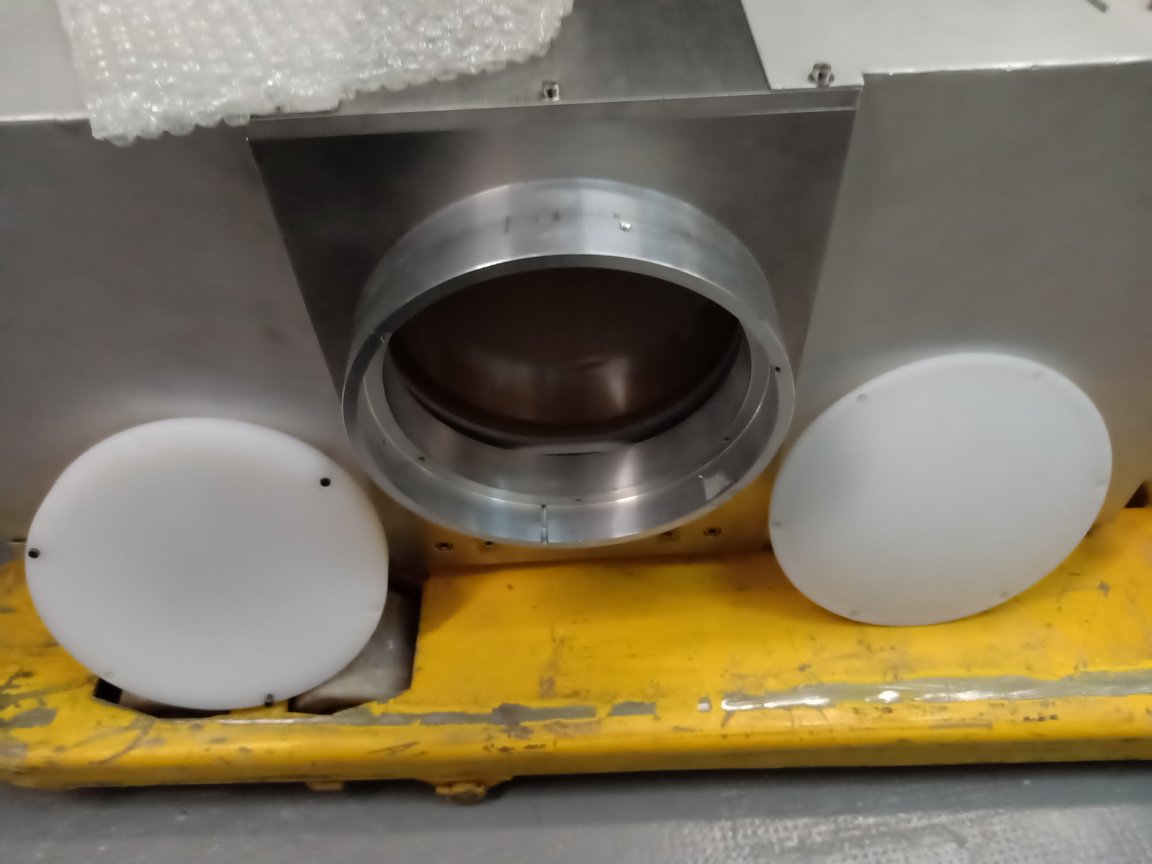
Using the Manual control screen from the PIMP_Server software run on the Raspberry control unit, the K mirror translation was tested successfully. The rise of temperature of the black bodies was also tested successfully. The only thing I couldn't test today is the connexion with the NIKA2 acquisition since it was in use for the Pool.
16:00-22:00: Sihan:
- 15:05 UTC doing pointing, focus, and calib_lscan on 3C84
- 13:30 UTC switch to project 166-24.
- 17:30 UTC we switch to total power because the tau is raising. Tuning values: 25, 5, 36.
- 17.38 UTC we switch to project 188-24.
- 19:00 UTC do pointing, focus, beammap on Uranus.
- 19:55 UTC switch to polarimetry mod, the tau is stable around 0.25, and the tuning values are: 23, 3, 36
22:00-04:00: Samuel+Hamza:
- 20:07 UTC Focus, pointing, calib1scan on Uranus. Project 015-17 (BFUN) source NGC2024S. The atmospheric conditions degraded super fast a some point a bit before 21:00 UTC (22:00 local time), during the series of scans, fluctuations passing from +-3 Jy/beam peak to peak on the pointing scan before the series, to 30 Jy/beam peak to peak on the pointing after the series. calib1scan on Uranus with the same conditions as the last scan (which is probably not usable, PI will see), then skydip and stop because tau is sky rocketing, and conditions become fast unusable even for EMIR @ 3 mm. 21:40 UTC.
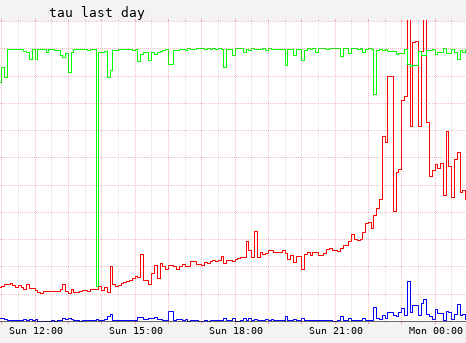
- 00:00 UTC over the last ~30 min tau seems to "stabilize" between 0.5 and 0.6, switch to EMIR E090. Project 143-24, source NGC1977. Cal on nearby QSO gives too noisy pointing, so do pointing and focus on Jupiter. 2 maps on source then too low.
- 01:30 UTC EMIR, proj 186-24, source J1325+3955... but Cal on nearby QSOs gives too noisy pointing. Impossible, we give up.
- 02:20 UTC EMIR, we decide to go to Mars for the pointing & focus, and go to J1102+5857, the nearest of the high priority sources of project 186-24.
Jan 20th, Monday
04:00-10:00: Francisco:
- 03:10 UTC : Taking over observations with EMIR using setting emirReceiver1_186-24. After 24 minutes of on-source time I realize that the source is not correct. We we observing on J1108+5831, but the right source to observe with this setting is J1102+5857.
- 03:50 UTC : Switching to source J1102+5857 with same setting. According to README file it needs 90 min on source. Every script execution with NSCANS=6 gives 3 min on-source so we need to repeat the script ~ 30 times. After 10 repetitions, checking pointing on 0923+392. Source is detected easily (tau has been stabilizing around 0.25 in the last hour). Then continue other 12 script executions. Checking pointing again on 0954+658 (a weaker source). Applying corrections and then finishing the last 8 executions.
- 06:40 UTC : We should have now obtained 90 min on source. Changing tuning to emirReceiver3_186-24. After tuning, we can see a strong RFI around 108.5 GHz. Juan Luis is doing some troubleshooting to understand where this comes from. Shutting the vertex and doing a hot/cold calibration shows a clean spectrum, so this reveals that RFI should come from the sky. After some tests and moving antenna from north to west, the RFI remains there. This is an AGN project and we don-t know where the CO line should lie, so we decide to switch back to emirReceiver1_186-24 and do the other source.
-- SL 22-01-2025 The origin of the RFI has been found, see last entry at end of Week --
- 07:30 UTC : Focusing on the strongest source (according to Xephem symbol size ![]() available in the area: 1253-055. Applying a small correction. Then pointing on 1308+326 and moving to next target J1326+3147. This also needs 90 minutes on/source.
available in the area: 1253-055. Applying a small correction. Then pointing on 1308+326 and moving to next target J1326+3147. This also needs 90 minutes on/source.
- 09:15 UTC : After 12 executions of the script we should have 1/2 of the integration time in this source. We tried to point on a close by source but the weather degraded a lot and data is very noisy. We decided to stop and do additional tests with the RFI seen before in the previous setting.
10:00-16:00: Sofia: The signal at 108.5 GHz is now not present at the spectra. Stopped due to high opacity.
16:00-22:00: Sihan: High wind and snowing. Antenna parked.
- In the afternoon Samuel and Victor (from the telescope mechanical workshop) checked the pieces designed by Carlos and 3D printed by Victor to mount in different ways a possible polariser to be used as analyser in front of NIKA2, as proposed by the COSMOCal and NIKA2 ExtCal teams (to possibly do a test to both investigate an anomaly in the data of last October COSMOCal+NIKA2 test, and possibly understand better the NIKA2 instrumental polarisation leakage). Below the pictures show the NIKA2 cryostat, the rotating half wave plate (HWP) and the NIKA2 entrance window, mounting test for a 1st series of pieces to be mounted on the HWP frame, mounting test for a 2nd series of pieces to be mounted on the HWP frame, mounting test for a 1st series of pieces to be mounted on the NIKA2 entrance window, mounting test for a 2nd series of pieces to be mounted on the NIKA2 entrance window. The 2 1st series which are adapted to a specific test polariser from the LPSC (Andrea) couldn't fit because of some unforeseen spacing constraints, but it's not a problem, they just need to be retouched, and a spacer is required for the ones to be mounted on the NIKA2 window.
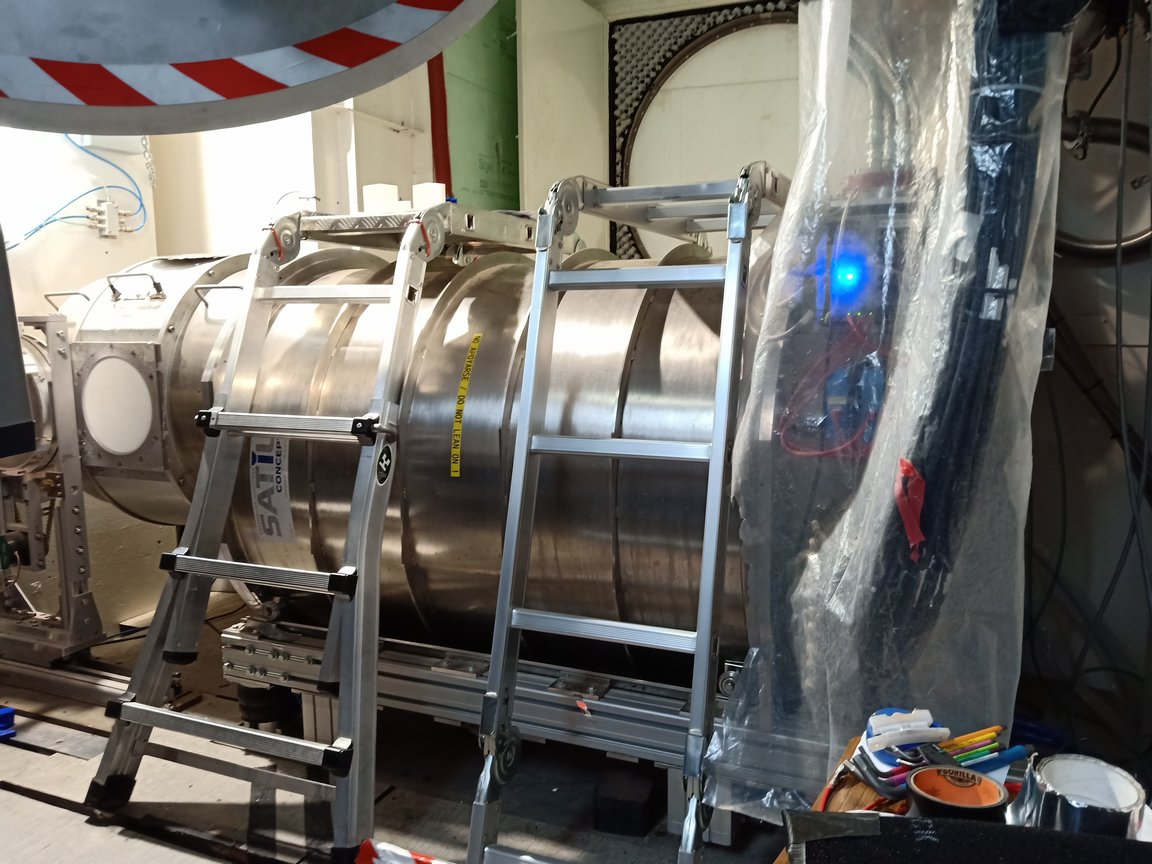
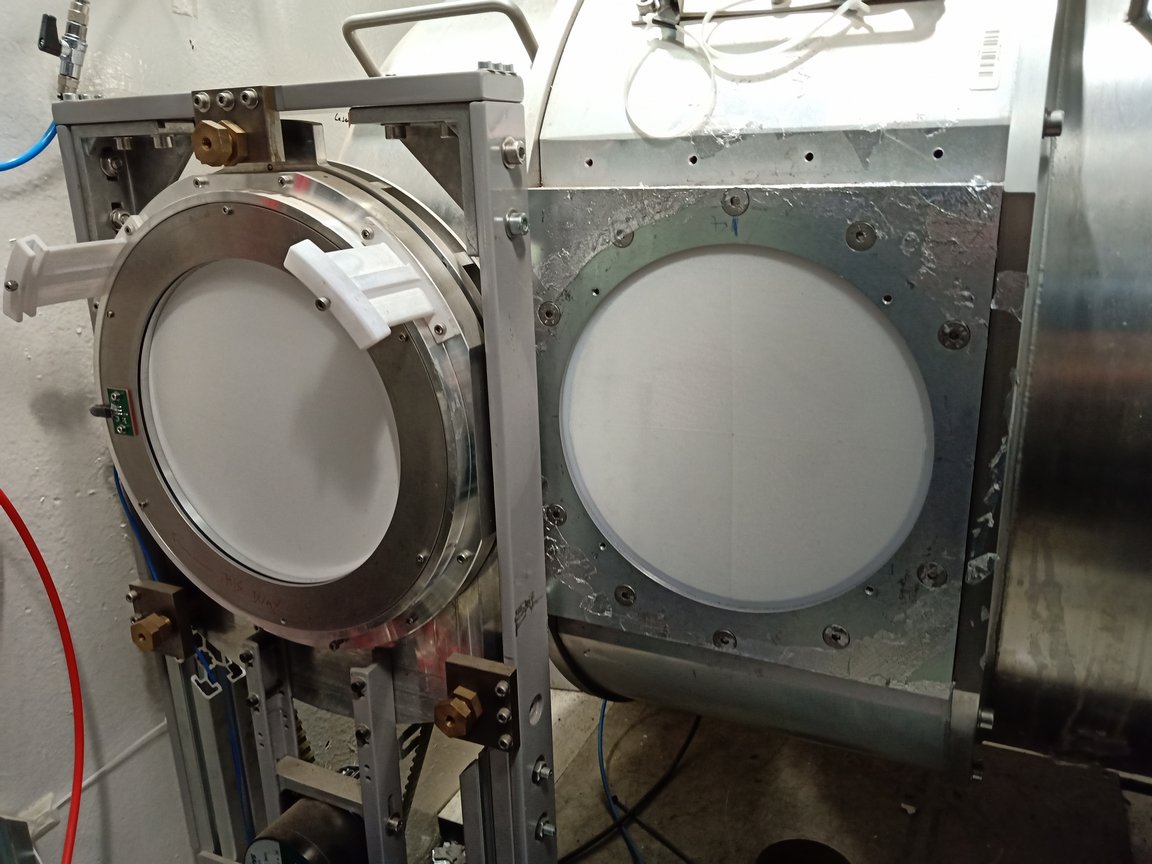

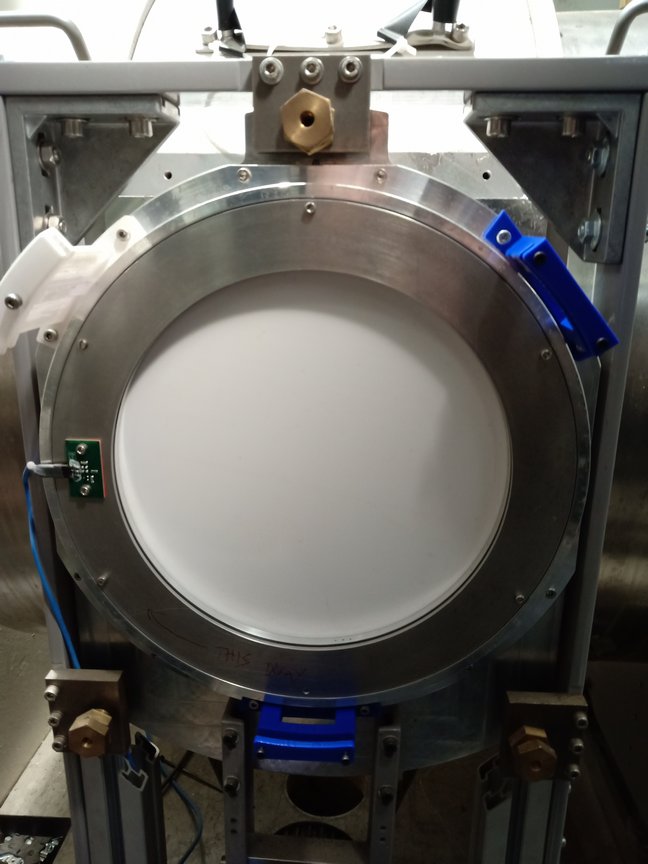

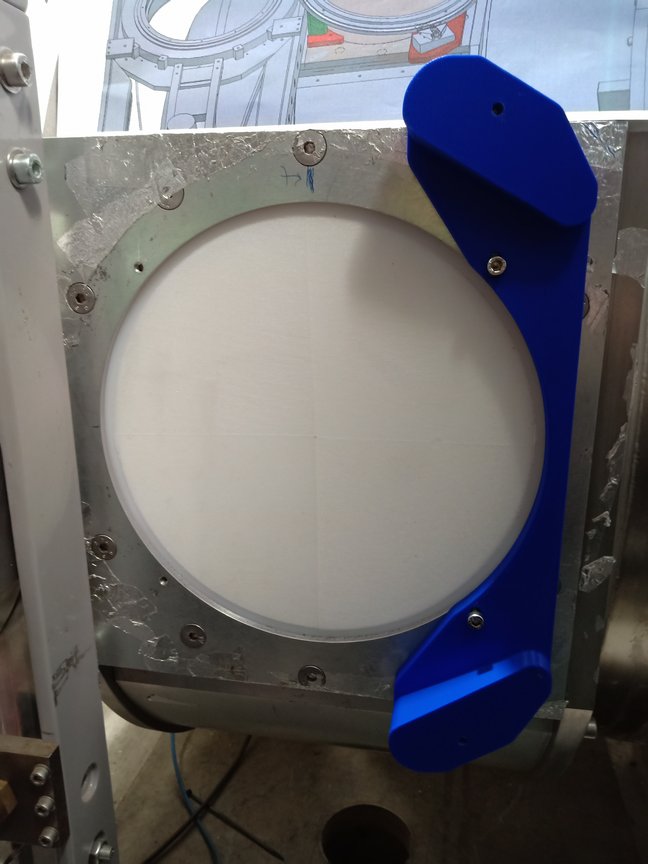
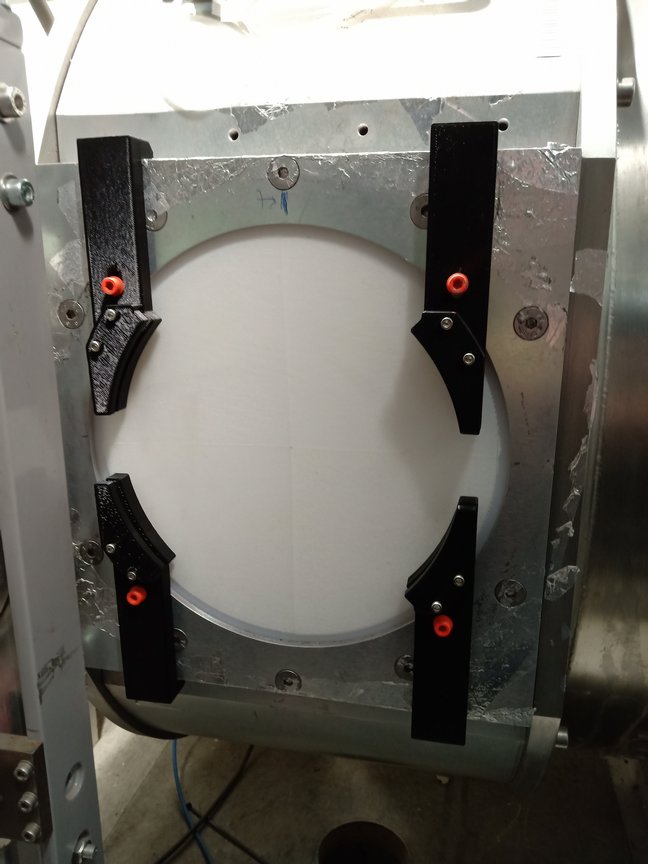
- The test of connexion of the PIMP control unit to the NIKA2 acquisition via the NIKA2 network was not done. But this is not very problematic as there's no reason at all that it changed since the last use in 2020. The most important was to check that the hardware was not broken and still controllable with the Raspberry control unit. Which was done yesterday.
22:00-04:00: Samuel+Hamza: Antenna parked (we are inside the clouds and an ice storm).
Jan 21st, Tuesday
04:00-10:00: Francisco+Pablo Torne: ...EHT Dress Rehearsal 2025 observations... (Antenna parked; high wind)
Tests using the EMIR Receiver E90 switching on and off the ExtCal in M2: it is confirmed it is at the origin of the 108.5 GHz. Samuel reminds the lines at which ExtCal emits, in parenthesis the signal should be extremely week in theory: (108.5), 139.9, 170.5, (201.5), 232.5, 263.5, 294.5, (325.5) GHz. It is circularly polarized below 200 GHz, linearly polarized above. It looks like something happened between the begin of the week when we couldn't see the calibrator with NIKA2 although we had already fixed the connection problem on the ExtCal box itself in M2, and two days ago when its signal appeared on EMIR. There was no physical intervention in between. Strange. We should conduct additional tests using alternatively EMIR (various receivers corresponding to the various lines emitted by ExtCal) and NIKA2 to try understanding better.
It looks like the electrical tests Dave had planed to do this week are maybe not necessary then. We should first do the tests suggested above.
1st side note from SL: I printed several documentation about ExtCal, put together and available on the NIKA2 table in the control room. Same for the PIMP also.
2nd side note from SL: ExtCal could be used for line calibration for EMIR.
!End of week!

